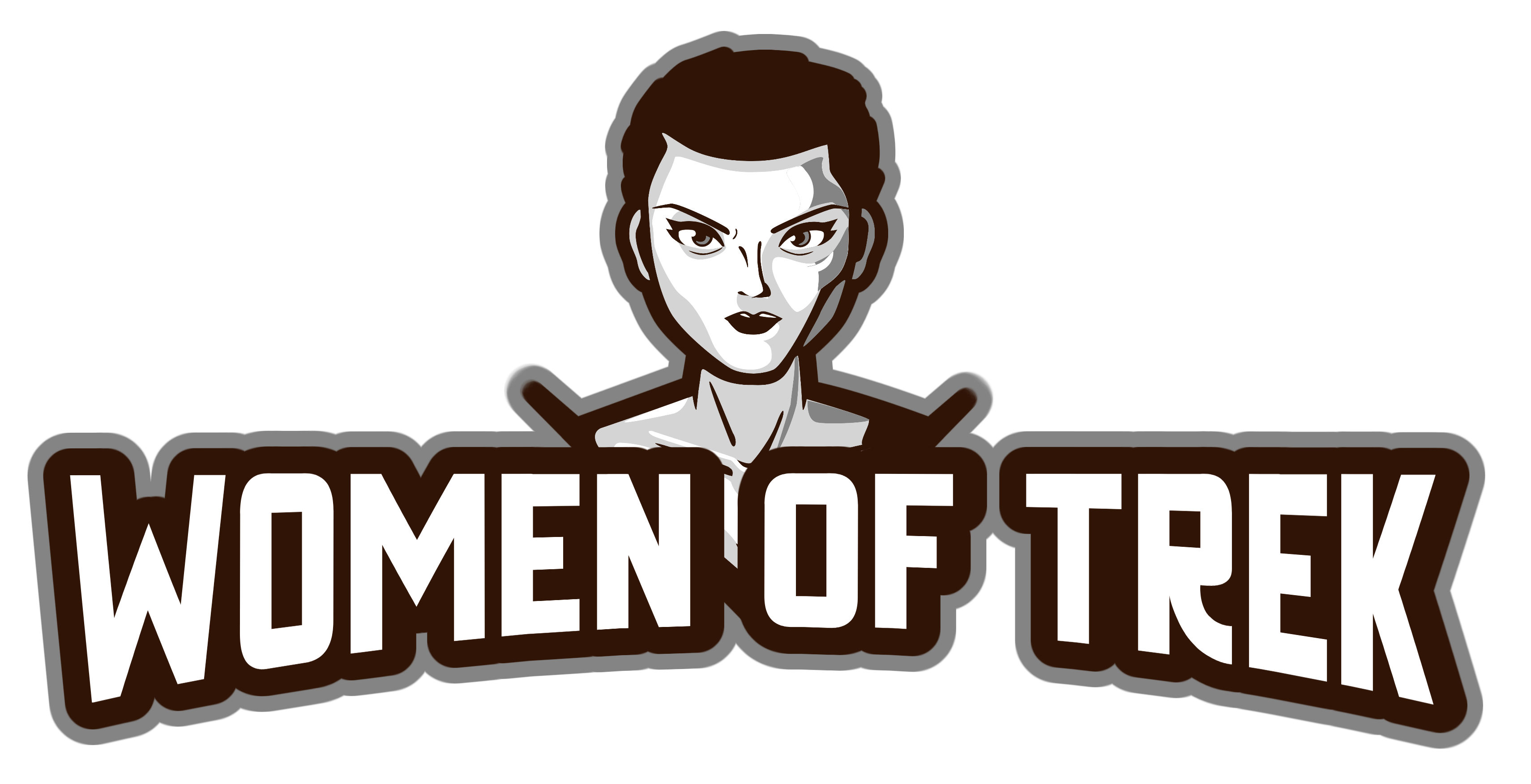
Series: Voyager
Character(s): Noss
Lori Petty played the role of Noss in the Star Trek: Voyager fifth season episode “Gravity”.


Like what you see? Buy us a Coffee!
Privacy Overview
The Best One-Off Characters In Star Trek: Voyager
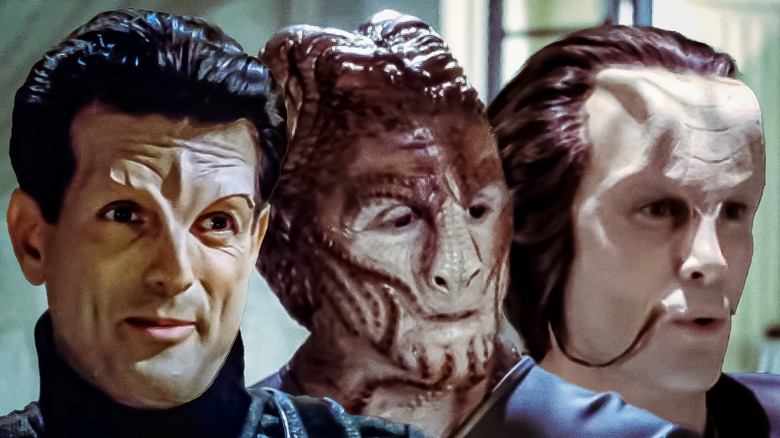
Across its seven seasons , "Star Trek: Voyager" followed the crew of the titular Starfleet vessel as it traversed the faraway Delta Quadrant to return home to Federation space. Led by Kate Mulgrew as Captain Kathryn Janeway , "Star Trek: Voyager" featured a memorable ensemble cast as the starship braved dangerous territory throughout its long journey. However, as beloved as the principal cast is, there are plenty of one-off guest stars on"Voyager" that helped elevate the show to new heights .
From formidable adversaries and villains to supporting characters that brought new dimensions to "Star Trek: Voyager," there is no shortage of excellent guest roles. Featuring a mix of prolific character actors and big-name stars, these characters not only enhanced their respective episodes but brought out the best in the main cast. With all that in mind, we've narrowed it down to the 12 best one-off characters from "Star Trek: Voyager's" 172-episode run,
Telek R'Mor (Vaughn Armstrong) — Eye of the Needle
Stranded in the Delta Quadrant, Voyager often turned to help from unlikely sources, including the Romulans in the first season episode "Eye of the Needle." Finding a wormhole capable of relaying messages back to the Alpha Quadrant, Voyager is surprised when the first presence they make contact with is Romulan Captain Telek R'Mor (Vaughn Armstrong). Janeway strikes a rapport with Telek, and the two captains overcome their mutual distrust for one another in a gesture of cooperation and good faith.
At this point in "Star Trek" history, the Romulans hadn't enjoyed the evolution into allies of the Federation that the Klingons had, and Telek brings a heightened level of tension and paranoia to the proceedings. However, this gives way to a touching chemistry between Telek and Janeway, a rare foil for the seasoned, no-nonsense Starfleet officer that makes Telek stand far above most guest stars on the show. As with most things "Voyager," this budding dynamic would take a bittersweet turn, but Telek is one of the more memorable one-off characters in the series early years that would help set the overarching tone.
Quinn (Gerrit Graham) — Death Wish
The second season episode, "Death Wish," as the title would suggest, is oddly morbid but also fits in the exploration of the human condition that "Star Trek" is known for. The Voyager is visited by Quinn (Gerrit Graham), one of the omnipotent Q Continuum, who pleads for the right to end his life after his long cosmic existence. As Q (John de Lancie) arrives to bring Quinn back to the Continuum to ensure this doesn't happen, Janeway becomes an arbiter between the two demigods.
As a god who has grown tired of his existence after witnessing untold eons pass, Graham brings immense world-weariness and end-of-life serenity to Quinn. Quinn's argument to be allowed to die before in an impromptu trial overseen by Janeway on a moral question with no easy answer is a standout scene. Juxtaposed against de Lancie's mischievously manic Q, Quinn's old soul performance is elevated all the more, balancing determination with melancholia in equal measure.
Henry Starling (Ed Begley, Jr.) — Future's End
The Voyager managed to arrive on Earth in the two-part Season 3 episode "Future's End," albeit with a time-bending twist. The crew is transported to Earth in 1996 rather than the 24th century. A time traveler that had been pursuing Voyager accidentally opens a temporal rift, with unscrupulous businessman Henry Starling (Ed Begley Jr.) harvesting technology from the time-traveler's ship and passing it off as his invention. As the Voyager moves to stop Starling from disrupting history further, they must contend with their presence threatening to upend the timeline.
Begley is a beloved character actor who has played numerous kindly, paternal figures throughout his extensive career and effectively plays against type as Starling. Starling is one the most conniving and manipulative antagonists in "Star Trek: Voyager," playing on the crew's sympathies to his advantage. In an age filled with egotistical technocrats with delusions of grandeur, Starling is one "Star Trek: Voyager" character that has aged particularly well and is certainly a worthy enemy for the crew.
Rain Robinson (Sarah Silverman) — Future's End
Ed Begley, Jr. isn't the only memorable guest star to appear in "Future's End," with comedian and actor Sarah Silverman getting in on the two-part time-travel action. Silverman plays Rain Robinson, an astronomer hired by Starling to keep an eye out for any additional starships passing near Earth. However, after making contact with the Voyager crew, Robinson finds herself targeted by an assassin hired by Starling to maintain the secret behind his ill-gotten technology empire.
What makes Silverman's performance as Robinson so enjoyable is her character's on-screen chemistry with Tom Paris (Robert Duncan McNeill) and Tuvok (Tim Russ). More than just providing comic relief, Silverman lights up the proceedings whenever she's on the screen. She plays particularly well off McNeill. If Begley is playing against type as the villainous Starling, Silverman, quirky and funny without overstaying her welcome, leans into her natural strengths as Robinson's world is completely turned upside-down.
Belle (Lindsey Haun) — Real Life
Throughout the entire run of "Voyager," the Doctor (Robert Picardo) developed a burgeoning sense of humanity as he became more autonomous from his base emergency medical hologram programming. Perpetually curious about the human experience, the Doctor programs an elaborate holodeck program that gives him a suburban family to come home to in the episode "Real Life." This descends into outright tragedy as the Doctor's programmed daughter, Belle (Lindsey Haun), has an accident that leaves the Doctor to discover the pain of enduring death.
"Real Life" could've very easily been one of the more distractingly melodramatic episodes of "Star Trek: Voyager" if it wasn't for Picardo and Haun giving this familial relationship a firm emotional foundation. If there was ever a character to remind audiences of the genuine human stakes behind the virtual realities on the Holodeck, the Doctor is the best suited to make that argument. Haun stands out from the rest of the guest cast to underscore the sense of heartbreak that the Doctor suffers as he faces the most traumatizing aspect of his newfound fatherhood.
Annorax (Kurtwood Smith) — Year of Hell
The Season 4 two-part episode "Year of Hell" perfectly captures the stranded premise and occasionally desperate tone of "Voyager." After taking a detour, Voyager is dogged by constant attacks for a year, incurring heavy damage and casualties to the starship. Leading the hunt is a maddened scientist named Annorax (Kurtwood Smith), who obsessively believes that destroying Voyager will undo fluctuations in the timeline and restore his deceased wife.
As Annorax, Smith pulls off the tricky feat of playing a pursuer as single-mindedly driven as Captain Ahab but with enough sympathy that we feel for the guy, even as he plots to destroy Voyager. "Year of Hell" is easily one of the best episodes in the entirety of "Star Trek: Voyager," and much of that elevated quality comes from the earnest intensity of Smith's performance. While Voyager may still be far from home by the episode's ending, Annorax has the best possible happy ending, giving the show a surprisingly heartfelt and hopeful note.
Quarren (Henry Woronicz) — Living Witness
"Star Trek: Voyager" has the benefit of largely taking place in a quadrant of the galaxy unfamiliar with Starfleet and the Federation, making the starship and its crew strangers in a strange land. "Living Witness" from Season 4 flips the perspective on Voyager's exploits through a museum exhibit approximately seven centuries in the future. The museum activates a backup copy of the Doctor, who is appalled by how Voyager is depicted and recounts to museum curator Quarren (Henry Woronicz) how history truly unfolded.
In Quarren, "Star Trek: Voyager" receives a somewhat impartial observer who puts the starship crew under scrutiny, with the Doctor serving as his friends' defender. With established history challenged, Quarren has to choose whether he stands with his people and what they've grown up to believe about Voyager or side with the Doctor's account. "Living Witness" is a unique transposition of Voyager's place in the Delta Quadrant in the eyes of those affected centuries later, with Quarren providing a point of view for the audience that is elevated by Woronicz's dynamic with Picardo.
One (J. Paul Boehmer) — Drone
"Star Trek: Voyager" continues themes of looking at trauma inflicted by the Borg Collective introduced in "Star Trek: The Next Generation" while humanizing the relentless enemy. These themes are primarily explored by Seven of Nine (Jeri Ryan), who finds a surprising kinship with a newly formed Borg drone, played by J. Paul Boehmer in the fifth season episode "Drone." Known simply as One, the drone is formed by nanobots from Seven interfacing with the Doctor's 29th-century technology during a transporter accident, with the Borg Collective hunting him to assimilate this advanced tech.
One helps Seven of Nine understand her status as a former drone liberated from the Collective, making their own observations about the Borg and humanity. Although the Borg are among the most menacing races in "Star Trek," Boehmer brings a sense of innocence to One as a drone naive to their nature and place in the galaxy. Innocence quickly gives way to tragedy when One, recognizing his entire existence poses a threat, must destroy the pursuing Borg. The moment is a beautiful full-circle scene, as a drone partially born of Seven reminds her of her resilience as he makes the ultimate sacrifice.
Kashyk (Mark Harelik) — Counterpoint
From the start of "Star Trek: Voyager," Capt. Janeway faces crisis after crisis as she maintains command over a composite crew and ship stranded without support from Starfleet. The fifth season episode, "Counterpoint," shows just how keenly strategic Janeway is as a commander. As Voyager passes through a sector with a ban on telepaths while secretly transporting refugees to safety, they are dogged by Inspector Kashyk (Mark Harelik), who takes a strong interest in human culture — and Janeway.
Janeway rarely gets an overt romantic foil, and Kate Mulgrew's dynamic with guest star Harelik makes for a gripping game of cat-and-mouse as both characters size each other up. More than just making eyes at each other, Janeway and Kashyk are playing mental chess with lives hanging in the balance. As Kashyk thinks he has finally tricked Janeway into lowering her guard, the captain reveals she has been playing him all along. This interplay is only made possible by Harelik being a credible opponent and love interest for Janeway, and the two actors take full advantage of this.
Noss (Lori Petty) — Gravity
Virtually every actor portraying a Vulcan in "Star Trek" has to convey the bulk of their character's repressed emotions through subtext and nuance. Tim Russ mastered this as Tuvok in seven seasons of "Star Trek: Voyager." The fifth season episode, "Gravity," gives Tuvok a love interest in Noss (Lori Petty). When Tuvok, Paris, and the Doctor are stranded on a remote planet (with the added wrinkle of their universal translators being broken), they struggle to find a way to contact Voyager. Tuvok keeps his emotions in check rather than admit his mutual attraction to Noss. This is made all the more complicated by the language barrier between them.
Having to speak primarily in an alien language and pretend to learn English is a thankless task for any actor and carries the risk of venturing into outright camp. In addition to deftly pulling off this daunting assignment, Petty creates a character charming enough for us to believe that Noss could compromise Tuvok's typically unflappable facade. Petty brings a steely resilience to Noss that cuts through her usual higher-pitched vocal delivery and demeanor, blending vulnerability with a determination that plays superbly opposite Russ.
Hirogen (J.G. Hertzler) — Tsunkatse
This might be a hot take, but while Dwayne Johnson's guest-starring appearance in the sixth season episode, "Tsunkatse," is the show's most memorable, it's not the best guest performance in the episode. This isn't a slight to Johnson so much as it is a compliment to the other guest stars appearing in "Tsunkatse," one of whom is "Star Trek" veteran J.G. Hertzler, whose character is simply credited as a Hirogen hunter. Of the two opponents that Seven of Nine takes on in the episode's central gladiatorial spectacle, Hirogen outshines the Champion (Johnson) because of the complexity Hertzler brings to the role.
When Seven of Nine is forced to fight in a series of mixed martial arts fights, she is mentored and healed by the Hirogen, who offers his sage wisdom to the new combatant. Of course, the Hirogen ends up being the final opponent Seven of Nine faces, with Hertzler displaying the quiet turmoil his character endures during the brutal duel. Hertzler excelled as noble Klingon leader Gen. Martok in "Star Trek: Deep Space Nine" and brings a more understated sense of honor as the Hirogen as a grizzled teacher and a tragic pugilist.
Penk (Jeffrey Combs) — Tsunkatse
J.G. Hertzler isn't the only "Star Trek: Deep Space Nine" alum to appear as a different character in "Tsunkatse," with fan-favorite Jeffrey Combs playing the conniving fight coordinator Penk in the episode. Penk captures Seven of Nine and Tuvok, coercing Seven of Nine to fight in the eponymous mixed-martial arts competition in exchange for life-saving medical treatment for Tuvok. Manipulative and sadistic, Penk revels in his dark side in contrast to Combs' more stoic antagonist Weyoun in "Star Trek: Deep Space Nine."
Like Hertzler, Combs is heavily made up for his "Voyager" role and scarcely recognizable. He clearly relishes the chance to play a much more gleeful villain. The sense of fun Combs' performance brings carries through the entire episode. Penk is as calculating as he is vicious. The Champion and the Hirogen may provide "Tsunkatse" with its physical opponents, but Penk stands out as the primary adversary.
The Greatest 'Star Trek: Voyager' Guest Stars (That You Probably Forgot About)
Did you know these actors had boldly gone to the Delta Quadrant?
How has it been 20 years since Star Trek: Voyager ended? The fourth live-action show in the franchise has found a resurgence in fans of late thanks to streaming, and rightly so. Star Trek: Voyager has its flaws, but the show also has a diverse cast, some fascinating storylines, and cool guest stars.
Star Trek as a franchise is known for its surprising cameos and guest performances. Since there are so many shows and characters, you’d be forgiven for forgetting a few notable actors who appeared during Star Trek: Voyager ’s seven seasons. If you’re wondering which names you’re missing, here are nine famous faces who appeared on the show.
RELATED: 'Star Trek: Picard' Season 2 Trailer Teases Some Wild Returns and Twists for the Paramount+ Show
Michael McKean as The Clown
Michael McKean is a veteran actor who has appeared in… just about everything. Before his recent critically acclaimed work on Better Call Saul , McKean was perhaps best known for his role in This is Spinal Tap , and has had a formidable career as a comedian. His role in Star Trek: Voyager Season 2, Episode 23, however, is anything but a laugh riot. In “The Thaw,” Harry Kim ( Garrett Wang ) and B'Elanna Torres ( Roxann Dawson ) are trapped in a computer program with the Clown (McKean) and his cohorts. Harry spends the entire episode being terrorized by this maniac, while the crew of Voyager try and figure out how to save him. The episode is an obvious attempt to subvert the expectation of both McKean’s presence and the circus iconography. Let’s just say, if you have Coulrophobia, this episode will likely exacerbate it.
Ed Begley Jr. as Henry Starling
Multiple Emmy nominee and Golden Globe nominee Ed Begley Jr. has had a prolific career playing so many different kinds of characters that it’s hard to keep track of them all. Begley Jr. guest starred in the Season 3 two-parter “Future’s End,” and boy, was he evil. He played Henry Starling, a futurist from 20th century Earth who becomes embroiled with Voyager, as the crew is trapped in the past, but can’t return to their own time without stopping Starling and correcting the timeline. Star Trek loves a time travel storyline, and an insidious villain like Starling ups the stakes considerably. He’s smarmy and considers himself the smartest person in the room, but he’s also extremely nasty. The scene where he captures the Doctor ( Robert Picardo ) is brief but still distressing to watch all these years later.
Sarah Silverman as Rain Robinson
She's a household name nowadays for her comedy, but one of Sarah Silverman ’s earliest on-screen acting roles was as Rain Robinson, also in the Season 3 two-parter “Future’s End.” Rain is a scientist in the 20th century who is the first person to spot an anomaly in the skies (Voyager’s warp signature). This information puts her life in danger, but luckily Tom Paris ( Robert Duncan McNeill ) and Tuvok ( Tim Russ ) come to her aid. Despite Tom and Tuvok’s attempts to disguise their true identities as time travellers, Rain deduces that there’s something fishy about them, and helps them on their mission against Starling. Silverman played the character with her quintessential wry humor and sarcasm, and her easy chemistry with Duncan McNeill made their characters’ budding and brief romance an adorable subplot in the episodes.
John Rhys-Davies as Leonardo da Vinci
John Rhys-Davies has such a towering presence that I could have sworn he appeared in several Star Trek: Voyager episodes. Turns out, he only starred in two of them, the Season 3 finale “Scorpion” and Season 4’s “Concerning Flight.” Rhys-Davies played the holographic version of Leonardo da Vinci, Captain Janeway’s ( Kate Mulgrew ) mentor, on the holodeck, pulling out his best Italian accent to take the captain under his wing. Leonardo acted as the captain’s confidante, as well as a sounding board for her ideas; while the character’s appearances were more ponderous than plot specific, “Concerning Flight” did give Rhys-Davies more work to do when the holographic character was accidentally transported to an alien planet. Hilarity definitely ensued.
Lori Petty as Noss
Lori Petty has such a wide-ranging filmography, but somehow her Star Trek: Voyager guest appearance is still a surprise. When Tom Paris and Tuvok are stranded on a mission in the Season 5 episode “Gravity,” they cross paths with Noss (Petty), an alien scavenger, and the trio form an unlikely bond as they remain trapped for months in the desolate landscape. Noss even learns to speak English to communicate better with Tom and Tuvok, after their universal translators are destroyed upon landing. It’s not long before Noss becomes attracted to Tuvok – his enigmatic, Vulcan aloofness was always appealing – but despite Noss’ overtures, Tuvok remains dedicated to his wife and family. Petty’s performance is more in line with her Point Break character Tyler; she’s sweet and naïve but can hold her own in difficult circumstances.
Jason Alexander as Kurros
For many, Jason Alexander has become synonymous with Seinfeld , but his role in the Season 5 episode “Think Tank” was far removed from his signature character. Alexander plays Kurros, the leader of a group of highly intelligent aliens. The Think Tank, as they call themselves, claim to have a way to prevent dangerous bounty hunters from pursuing Voyager. But the group soon show their true colors when they insist on recruiting crewmember Seven of Nine (Jeri Ryan ). Alexander plays against type here — the episode would have been completely derailed if Alexander had been over the top, but instead he plays Kurros as calm and sinister, which makes the character even scarier.
Daniel Dae Kim as Gotana-Retz
In the Season 6 episode “Blink of an Eye,” Voyager gets accidentally trapped in a planet’s orbit, thereby inadvertently altering the planet’s history forever. The planet experiences a time differential which causes years to pass on the surface without much time going by for Voyager’s crew. As the generations are influenced by Voyager’s presence, two astronauts land on the titular ship. Daniel Dae Kim ’s Gotana-Retz survives the landing and although his character is mostly offscreen, he plays a significant part in helping Voyager break free. Dae Kim only appears in the fourth act, but his character arc is remarkably memorable. The last shot of his character remains a bittersweet moment in the show’s history. Star Trek has been at the forefront of diverse casting choices, and Dae Kim is part of a still short, but brilliant, list of Asian guest stars in the franchise.
Dwayne "The Rock" Johnson as The Champion
Dwayne Johnson is one of the biggest movie stars today, but his road to stardom had an unlikely pitstop aboard the starship Voyager. Admittedly, the role of the Champion in the Season 6 episode “Tsunkatse” wasn’t very different from playing The Rock on Monday Night Raw. In the episode, the crew of Voyager are invited to watch a gladiatorial tournament, but their excitement dissipates when one of the fighters is revealed to be their own Seven of Nine. She and Tuvok had been captured by aliens, and Seven is subsequently forced to fight in the match in order to save Tuvok. Johnson is very much in his element in this role, playing to his strengths as a famed wrestler. It's more of an extended cameo than a role, but you will still be on the edge of your seat waiting to see if The Rock can beat a Borg.
Mark Sheppard as Leucon
As prolific character actors go, Mark Sheppard is high on the list. He’s appeared in everything in every genre, so why would a Star Trek show be any different? Late in Season 6, Sheppard guest-starred as Leucon Icheb, the long-lost father of Voyager’s latest resident, Icheb ( Manu Intiraymi ). Icheb was a child who had been assimilated by the Borg before being rescued by the crew of Voyager. In “Child’s Play,” Voyager locates his parents on the Borg-ravaged Brunali homeworld. Sheppard is infamous for playing morally ambiguous characters, and this episode plays to his strengths as it keeps you guessing about Leucon’s actions and motivations. In the end, this is a heartbreaking installment, and much of that comes down to Sheppard’s scene-stealing turn as a parent with a difficult decision to make.
Star Trek: Voyager is streaming on Paramount+, Netflix, Amazon Prime, and Hulu.
KEEP READING: 7 Sci-Fi Shows to Binge If You Love ‘Star Trek’
Den of Geek
Star Trek Voyager: 10 Great Guest Performances
Remember when Sarah Silverman was in Star Trek: Voyager? We salute that and 9 other great guest stars on the show...

- Share on Facebook (opens in a new tab)
- Share on Twitter (opens in a new tab)
- Share on Linkedin (opens in a new tab)
- Share on email (opens in a new tab)
Star Trek: Voyager doesn’t share the good reputation of its predecessors The Next Generation and Deep Space Nine , with some fans disappointed that the inherent conflict between Starfleet and Maquis characters was not explored further, others perhaps put off by the really rather dull and occasionally ridiculous second season. However, Voyager was as capable as any other Star Trek series of producing memorable stories and excellent performances, and for those of us for whom it is our favorite branch of the Star Trek franchise (yes, we do exist) it is worth celebrating some of the things it did really well – in this case, the actors and actresses who came to join the show for guest performances.
Note: This list is celebrating guest performers who came in for one, or at most two, guest performances as a specific character (though their character may have made more appearances in other branches of the franchise, or the actor may have appeared as other characters). This is why you shouldn’t expect to see characters like John de Lancie’s Q or Dwight Schultz’s Reg Barclay on the list – although they were guest stars, they recurred several times.
10. Sarah Silverman as Rain Robinson in Future’s End Parts 1 & 2
Sarah Silverman is best known as a comedian, but in Voyager she played the fairly straight role of Rain Robinson, perky astronomer and brief love interest for Tom Paris. It’s a fairly thankless role, mostly requiring Silverman to stand up for herself while utterly confused, but she does it well, standing up to Ed Begley Jr’s maniacal scientist and offering Paris a genuine reason to hesitate as he leaves her behind in the twentieth century.
9. Mark Harelik as Kashyk in Counterpoint
Janeway had a few one-off love interests over the course of the show, plus her ongoing seven-year flirtation with Chakotay and a thoroughly indecent proposal from Q. Kashyk, however, was one of the most interesting, a ruthless Space Nazi Janeway never quite trusts, but very much wants to. Mark Harelik walks a fine line as he makes Kashyk simultaneously charming enough to provide a believable match for the Captain, but slimy enough not to appear entirely trustworthy. A good performance in a nicely put-together episode.
Ad – content continues below
8. Lori Petty as Noss in Gravity
We’ve seen a few variations of the story of an emotional human falling in love with an emotionally unavailable Vulcan since Christine Chapel’s unrequited love for Spock in the early years. For Noss and Tuvok in Gravity , this uncomfortable situation is amplified by their situation, stranded on a hostile planet with only Tom Paris and the Doctor for company, not even sharing a common language.
Lori Petty’s performance is fragile and brittle, but tough at the same time, her high-pitched voice put to excellent use making Noss sound foreign and alien as she struggles to learn English with the universal translators broken. To be alien and relatable at the same time is not easily done, and she does it very well.
7. Henry Woronicz as Quarren in Living Witness
The story in this season four episode is carried by one of Voyager ’s most popular characters, the Doctor, and Henry Woronicz as a man whose entire world-view is turned upside down over the course of the story. Woronicz, playing a historian with a serious attitude but also a more romanticising side, gives a performance that’s quiet but intense, helped by nice chemistry with Robert Picardo. An episode like this rests on the abilities of the guest performer, and Woronicz pulls it off perfectly.
6. Lindsey Haun as Belle in Real Life
Real Life is an odd episode in many ways, partly rehashing elements of The Next Generation ’ s The Offspring , adding a dose of soap opera, and mixing them in with some very odd attitudes on the part of some characters. What does work about it, though, is the Doctor’s relationship with his holographic daughter, Belle, and that couldn’t work without a lively performance from a young Lindsey Haun (later to appear in a rather different role as Hadley in True Blood ).
The character has the potential to be rather grating, but Haun brings a humanity to her non-human role that makes the story’s emotional climax work and work surprisingly well.
5. Vaughn Armstrong as Telek R’Mor in Eye Of The Needle
Eye Of The Needle is an early classic, making use of Voyager ’s unique situation in a well-structured episode with a gut punch of an ending. That ending couldn’t work without a performance from the guest star that makes Telek both believably cold and Romulan, and simultaneously extremely likeable.
Vaughn Armstrong holds the record for playing the largest number of separate characters across four series in the Star Trek franchise (12), and the reason various producers and casting directors kept asking him back is because he can always be relied upon to give a heartfelt, nuanced performance, inhabiting each different alien, human or cybernetic character in a different way. Of his five roles in Star Trek: Voyager , Telek R’Mor is the most memorable and, along with Lansor/Two of Nine in season six’s Survival Instinct , the most touching.
Get the best of Den of Geek delivered right to your inbox!
4. Susan Diol as Denara Pel in Lifesigns and Resolutions
Season two, overall, was not a high point for Voyager , but one of its genuine high points was Lifesigns , also the episode that made the most effective use of the permanently unhealthy Vidiians (though season one’s Faces come close). Much of the episode’s success is down to Susan Diol’s quietly emotive performance as Denara Pel, a woman living with a serious chronic illness who gets the chance, for just a few days, to live without it, and who takes full advantage of that opportunity.
The story is designed primarily to provide character growth for the Doctor, but Diol’s sympathetic performance ensures that it is also a story about the on-going effects of chronic illness on the sufferer’s sense of self, told through her carefully understated but heartfelt reactions to her situation.
3. J. Paul Boehmer as One in Drone
J. Paul Boehmer gave tow equally impressive performances in Voyager , and it’s hard to say which is the more effective between his chillingly authoritarian Nazi officer in season four’s The Killing Game , or his innocent, childlike baby Borg in season five’s Drone . Both are effective, but Drone just pips it, because the Nazi officer, as well done as he is, is something we’ve seen before (owing a little to Ralph Fiennes’ performance in Schindler’s List , and helped by the fact the Boehmer actually looks a bit like Fiennes).
In Drone , however, Boehmer takes a character we’ve already seen two iterations of, the Borg drone learning to be an individual, and adds his own special sense of vulnerability. Comparisons with The Next Generation ’s Hugh are inevitable, but Boehmer makes the role his own despite the obvious similarities.
2. Kurtwood Smith as Annorax in Year Of Hell Parts 1 & 2
It would have been easy to overplay the time-altering villain of arguably Voyager ’s best two-parter (perhaps its best episodes). Over the course of two episodes, it becomes increasingly clear that Annorax has started to become a little unhinged in his endless quest to repair the damage he did the first time he used his reality-changing device, convinced that Time itself has a grudge against him.
However, former President of the Federation (in Star Trek VI: The Undiscovered Country ) Kurtwood Smith plays Annorax with a quiet intensity that only slowly allows the extent of his mania to be revealed, making Chakotay’s initial sympathy with him plausible and ensuring that he is a tragic and understandable character, rather than a simple moustache-twirling villain.
1. Gerrit Graham as Q2/Quinn in Death Wish
Some Q episodes can be a bit like marmite, beloved by some, heartily disliked for their occasional silliness or stretched plausibility by others. Some, however, are genuine classics, and this is one of them, thanks in no small part to Gerrit Graham’s whimsical but simultaneously sad performance as a suicidal member of the Q Continuum. An episode that essentially debates the right to die, the underlying moral question is one for which there is no simple resolution, but Graham’s thoughtful performance ensures that the episode as a whole works well, presenting a character the audience can sympathise with regardless of whether or not they agree with his ethical point of view, and offering a neat balance to John de Lancie’s more emotive, extravagant Q.
Honorable mention: both Susannah Thompson and Alice Krige do excellent work as the Borg Queen (Thompson in Dark Frontier and Unimatrix Zero Parts 1 & 2 , Krige in Endgame ) but while each actress only appears once or twice, the character recurs too often to count for this list. I don’t make the rules. OK, that’s a lie, I do make the rules, but we have to draw a line somewhere!

Juliette Harrisson | @ClassicalJG
Juliette Harrisson is a writer and historian, and a lifelong Trekkie whose childhood heroes were JRR Tolkien and CS Lewis. She runs a YouTube channel called…
- Show Spoilers
- Night Vision
- Sticky Header
- Highlight Links

Follow TV Tropes
http://tvtropes.org/pmwiki/pmwiki.php/Recap/StarTrekVoyagerS5E13Gravity
Recap / Star Trek Voyager S 5 E 13 Gravity
Edit locked.


This episode contains the following tropes:
- Absence Makes the Heart Go Yonder : Tom points out that it's not logical for Tuvok to remain faithful to a wife who is 50,000 light years away that he'll likely never see again. Tuvok is not amused .
- A Day in the Limelight : A Tuvok episode.
- All Love Is Unrequited : Noss develops feelings for Tuvok who is Happily Married (or devoted in Vulcan terms) to his wife.
- The Vulcan Master instructing young Tuvok admits that the power of his emotions frightens him. As he points out, to deny this would be illogical.
- Tuvok says that beneath their apparent serenity, Vulcans constantly struggle with volatile emotions.
- Beware the Nice Ones : Tuvok is not often forced to engage in hand-to-hand combat, but here he easily dispatches a squad of raiders by himself. It's also a reminder that Vulcans are physically faster and stronger than most aliens, and their dedication to logic is a blessing to others.
- Big Damn Heroes : Tuvok turns up in the nick of time to save either Noss or Tom on three occasions .
- Book Ends : The episode begins with Young!Tuvok beginning his studies with the Vulcan Master, and ends with him leaving having regained his control of emotions.
- The multi-spatial probe from "Extreme Risk" is used to explore the sinkhole.
- Tom recalls his lengthy courtship of B'Elanna Torres.
- Tuvok responds to the suggestion that he's secretly a big softy with, "There is no need to be insulting" as per Spock .
- When young Tuvok is led to believe the girl he's smitten with has fallen for another Vulcan, Tuvok says he will challenge his rival, a reference to the kal-if-fee from TOS "Amok Time".
- The Vulcan Master lists the emotions that an infatuated Tuvok is experiencing, just as Tuvok did for an infatuated Harry in "Alter Ego". In fact this episode explains how Tuvok knew how to deal with feelings of unrequited love in the first place.
- Cannot Spit It Out : Tuvok is unwilling to admit his feelings for Noss. But at the end of the episode he forms a Mind Meld with her, whereupon she just smiles and says, "I understand."
- Noss borrows Tuvok's catchphrase of "Fascinating" at one point.
- Averted both times when the Doctor is reactivated (probably because his program is already active in the emitter). When Tuvok is injured, the nature of the medical emergency is already pretty obvious anyway.
- Commander Crash : Tuvok's mere presence on a shuttle causes yet another crash. Though Tom was flying it so maybe we should blame him.
- Contemplation Location : Tuvok meditates on the rocks to get control of his emotions regarding Noss, but Tom follows him and insists on discussing the issue.
- Everyone Can See It : Tom can see Tuvok is attracted to Noss despite his denials.
- Flash Back : Tuvok keeps flashing back to his youth where he struggled with his emotions and Vulcan teachings.
- Florence Nightingale Effect : Noss kisses Tuvok after he's injured in an ambush.
- Former Teen Rebel : As a teenager, Tuvok became infatuated with a Terrellian female at his school who rejected his advances. As a result he rebelled against the Vulcan philosophy of logic and emotional control, and was banished to the care of a Vulcan Master.
- From Bad to Worse : The shuttle has fallen into a subspace sinkhole with no way of getting out. Thanks to the time-distortion, they're trapped for months on a desert planet before Voyager can even find them. An alien race is planning to close the sinkhole and won't wait for any rescue operation. Then Chakotay delivers the Wham Line . Chakotay: Ready for the bad news? Janeway: You're kidding. Chakotay: The gravitational stress is increasing. Seven believes the sinkhole is on the verge of collapse. When it does, everything inside will be crushed.
- Future Spandex : Noss' form-fitting black outfit really isn't suitable for a desert planet, though it's likely something she scavenged.
- Getting Hot in Here : More tank-top fanservice , this time involving Tuvok.
- The Hermit : Young Tuvok studied in isolation under a Vulcan Master until he could learn to suppress his emotions.
- Holding Hands : Tuvok holds Noss' hand as he leads her to the transporter pad.
- Ice-Cream Koan Young Tuvok: If I was meant to deny feelings, why was I born with them? Where's the logic in that? Vulcan Master: Hidden for you to find. Or in plain sight for you to ignore. Young Tuvok: You speak in riddles because the truth frightens you!
- Inconvenient Attraction : Tuvok really doesn't want to suffer the anguish of unrequited love again.
- Averted on the planet: Noss, Tom and Tuvok have to hunt for food and scavage supplies from other downed ships. The Doctor is also taken offline for months, so they can conserve the power cell of the mobile emitter (and possibly use it as a backup power source).
- Interspecies Romance : Albeit of the unrequited kind .
- I'm a Doctor, Not a Placeholder : The Doctor has to be shut down because they may need to use his mobile emitter as a power source. He retorts, "I'm a doctor, not a battery!"
- Kiss Diss : When Noss tries to kiss Tuvok, he pushes her away.
- Leave the Two Lovebirds Alone : Tom orders everyone out of the transporter room so Tuvok can say goodbye to Noss in private.
- Love Confession : All the more meaningful for being completely non-verbal. Tuvok doesn't have to say the words, because he can share his thoughts and feelings via mind-meld.
- Love Makes You Crazy : For Vulcans it does, which is why Tuvok doesn't want to surrender to his feelings. Tuvok: I lost all sense of who I was. The emotional attraction I felt became a kind of insanity. Paris: Tuvok, everyone feels a little insane when they fall in love, but it's worth the risk. Tuvok: For you, perhaps. But I am Vulcan. My natural emotions are erratic, volatile. If I don't control them, they will control me.
- Luckily, My Shield Will Protect Me : The forcefield on Noss' crashed vessel still works, enabling her to hold off scavengers. Until the final act when they launch a determined assault using photonic charges that ultimately overloads the emitter and brings the barrier down.
- Mandatory Line : Neelix only appears briefly in the last act under the guise of asking Noss for her recipe for sautéed spider , before he's shooed away by Tom.
- The Matchmaker : Tom, as lampshaded by Tuvok who does not appreciate his efforts.
- Not So Stoic : The episode delves into the emotions beneath Tuvok's calm Vulcan exterior.
- Obstructive Bureaucrat : The rescue is made more difficult than it should be thanks to the efforts of Supervisor Yost to close the sinkhole. When he's ready six hours ahead of schedule, he goes ahead without waiting for Voyager .
- Old Master Vulcan Master: You wish to be taught? Young Tuvok: I would question everything you say. Vulcan Master: You would not be a worthy pupil otherwise.
- Omniglot : The Doctor can speak to Noss in her language because the Universal Translator is part of his program. He ends up teaching her fairly decent Federation Standard, though some more esoteric concepts still have to be translated: for instance, Noss has to ask him in her own language how to say 'love' because the Doctor hadn't taught her that, presumably seeing it as irrelvant to their situation.
- Orbital Kiss : Although a kiss isn't involved, the camera does a half-circle around Tuvok and Noss as they Mind Meld , showing its romantic subtext.
- Pardon My Klingon Noss: Logic! I hate logic! Tuvok: Your emotions will only exacerbate the situation. Noss: Shevrot kat! Tuvok: Insulting me will not help.
- Race Against the Clock : Voyager only has a day to rescue their crewmembers before another alien race closes the sinkhole to prevent other ships being pulled in. By the time they're ready, the aliens have decided to go ahead of schedule, which gives them only 30 minutes. As they count down the last few seconds to transport, Tuvok has to race out and rescue Noss who's trying to repair the forcefield in the face of an assault of scavengers trying to breach her ship. Because of the Year Inside, Hour Outside time dilation, they have to fend off an attack for the better part of an afternoon while for Voyager , its just a few minutes.
- Rescue Romance : Tuvok meets Noss when he saves her from two attackers.
- Reverse Polarity : Voyager escapes being pulled into the sinkhole by reversing the polarity of its shields.
- Robinsonade
- Scavenger World : The only supplies on the planet are brought in by other crash victims, so there's savage competition for resources . Noss is introduced when she steals Tom's medkit, and then Tuvok saves her from being robbed herself.
- Tastes Like Friendship : After he first rescues her, Tuvok offers Noss a ration bar (no small gift on a planet where you have to hunt your food). They also bond while cooking up their latest catch of spiders .
- Weird World, Weird Food : The main source of protein on the planet consists of large spider-like creatures. Paris: I don't know what's worse. Catching them or eating them. Noss: No poison . Paris: Well they may not be poisonous, but they give me the creeps.
- Year Inside, Hour Outside : After being stranded for two months, Tom is disappointed that his girlfriend B'Elanna doesn't miss him more because for her, only two days have passed.
- You No Take Candle : Noss speaks this way because the Universal Translator isn't working. She proves Eloquent In Their Native Tongue after Voyager rescues them and Noss can speak using the UT.
- Star Trek: Voyager S5 E12: "Bride of Chaotica!"
- Recap/Star Trek: Voyager
- Star Trek Voyager S 5 E 14 Bliss
Important Links
- Action Adventure
- Commercials
- Crime & Punishment
- Professional Wrestling
- Speculative Fiction
- Sports Story
- Animation (Western)
- Music And Sound Effects
- Print Media
- Sequential Art
- Tabletop Games
- Applied Phlebotinum
- Characterization
- Characters As Device
- Narrative Devices
- British Telly
- The Contributors
- Creator Speak
- Derivative Works
- Laws And Formulas
- Show Business
- Split Personality
- Truth And Lies
- Truth In Television
- Fate And Prophecy
- Edit Reasons
- Isolated Pages
- Images List
- Recent Videos
- Crowner Activity
- Un-typed Pages
- Recent Page Type Changes
- Trope Entry
- Character Sheet
- Playing With
- Creating New Redirects
- Cross Wicking
- Tips for Editing
- Text Formatting Rules
- Handling Spoilers
- Administrivia
- Trope Repair Shop
- Image Pickin'
Advertisement:
Gravity Stardate: 52438.9 Original Airdate: 3 February 1999
<Back to the episode listing
Star Trek ® is copyright of CBS Studios Inc . Copyright © 1966, Present. The Star Trek web pages on this site are for educational and entertainment purposes only. All other copyrights property of their respective holders.
- Buy the Book…
- Reviews Hub

the m0vie blog

Following Us
- Adding Our RSS Feed to Your Gmail
- Following our Feed in Internet Explorer
- Millennium (Reviews)
- Star Trek: Deep Space Nine (Reviews)
- Star Trek: Enterprise (Reviews)
- Star Trek: The Next Generation (Reviews)
- Star Trek: The Original Series (Reviews)
- Star Trek: Voyager (Reviews)
- The X-Files (Reviews)
- X-Files Fandom Poll Form
Check out the Archives

Awards & Nominations

Star Trek: Voyager – Gravity (Review)
Gravity is a powerful story, all the more effective for its relative simplicity.
Tuvok has been one of the most overlooked and ignored regular cast members on Star Trek: Voyager . The later seasons tend to neglect Harry Kim and Chakotay, but they had been given considerable focus in the earlier years of the show. Chakotay had been a major focus in The Cloud , State of Flux , Cathexis , Initiations , Tattoo , Manoeuvres and Basics, Part I . Kim had taken centre stage in Emanations , Prime Factors , Non Sequitur and The Thaw . In contrast, Tuvok remained relatively anonymous, more of a supporting player than a narrative focal point.
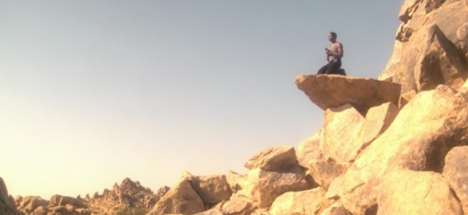
Vulcan on a ledge.
In hindsight, this appears a rather strange choice. Tuvok is the first full-blooded Vulcan character to appear as a regular on a Star Trek show. Spock is easily the most iconic character in the franchise, to the point that he would be the torchbearer for the JJ Abrams reboot and his family still haunts Star Trek: Discovery . As such, having a fully Vulcan character should have led to all manner of interesting stories. After all, Tuvok was introduced in Caretaker as a spy working undercover in the Maquis. There should have been a lot of material to mine in the set-up.
However, for most of the run of Voyager , Tuvok seemed cast in a supporting role. He was the investigator in episodes where the crew were falsely accused, as Paris was in Ex Post Facto or Torres was in Random Thoughts . He was a reliable sounding board for other characters, as with Kes in Cold Fire or Neelix in Rise or Seven of Nine in The Raven . He was even effectively employed as a mind-controlled monster in episodes like Cathexis and Repression . Tellingly, most of the handful of episodes focusing on Tuvok focus on events where he is not himself; Tuvix , Riddles .
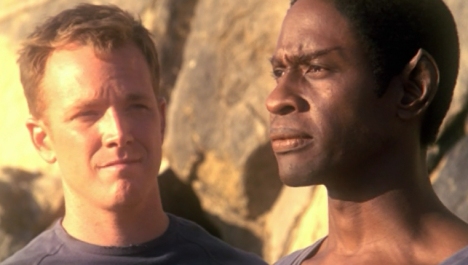
Vulcan love slave.
This is a shame, as there is a lot of fertile ground to explore within Vulcan psychology. Logic is never as clean or simple as Spock made it sound. Existence is full of logical contradictions and inconsistencies. The two best Tuvok-centric episodes of Voyager tend to focus on these inconsistencies. Meld is an episode in which Tuvok asks questions for which there can be no answer, and in which his insistence that the universe is an ordered and logical structure pushes him to some very dark places. Gravity explores the long-standing myth that Vulcans are emotionless.
Gravity is a surprisingly influential episode of Voyager , an episode that explores the implications of an idea which the larger Star Trek franchise had taken for granted for more than thirty years. It is an episode that feels unique in the larger context of Voyager , one build as much around character as action. It is story about love and repression, one rooted very much in who Tuvok is. It might just be one of the best Vulcan-centric stories in the franchise.
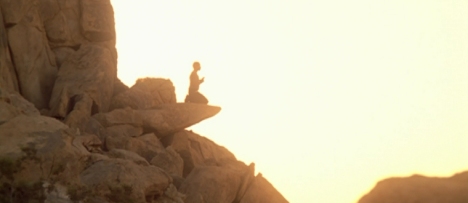
Tuvok lightens up.
As with any long-running franchise, Star Trek has cultivated a mythology around itself. The franchise has become iconic and ubiquitous, an instantly identifiable aspect of American popular culture. Kirk and Spock are characters recognised across the world. A significant percentage of the American population understands what a “Klingon” is. Catchphrases like “live long and prosper” might not have the same impact as “may the force be with you” , but they have a reach that extends beyond the ratings of individual episodes.
Along the way, the franchise has build up a fair amount of mythology. There are certain aspects of Star Trek that are taken for granted, and accepted without question. People assume that the words “beam me up, Scotty” were spoken on the original show, when they never were . Fans insist that Vulcans never lie, when Spock has been known to bend (and even break) the truth when the occasion demanded it . Fans were outraged when Star Trek: Enterprise had the tenacity to present Vulcans in an unflattering light, glossing over episodes like Amok Time or Journey to Babel .
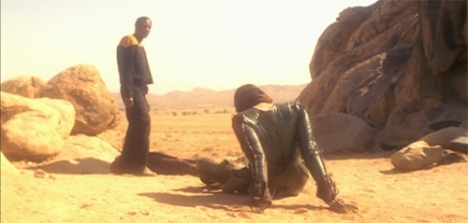
Just deserts.
However, one of the more persistent pieces of Star Trek mythology is the idea that Vulcans do not have emotions, that they are completely lacking in feelings and are effectively organic robots with pointy ears. David Gerrold summarised this approach to the Vulcans in The World of Star Trek :
The Vulcan culture finally rejected its savage heritage – rejected it so thoroughly that they rejected anything that smacked of it as well. Wars are emotional experiences that stem from individuals and groups of individuals and nations acting irrationally, reacting with their adrenals instead of their brains. In rejecting war and savagery, Vulcans were forced to also reject emotions. Just as Freedom and Opportunity are the spoken goals of most Earth cultures, so did Rationality and Logic become keystones of the Vulcan culture. Vulcans carefully bred emotions out of themselves. They conditioned themselves and their children to be logical. They consciously altered the direction of their evolution.
This feels very much like an attempt at revisionism from the production team, much like the revisionism that Gene Roddenberry attempted with Star Trek: The Motion Picture . It was a clear attempt to ignore the actual content of earlier episodes in favour of a blanket official statement.

It came from above.
After all, the original Star Trek repeatedly suggested that Vulcans were far more emotional than Spock would ever acknowledge, as Kirk and McCoy would repeatedly tease him. Even leaving aside Spock’s emotional outbursts in episodes like The Naked Now or This Side of Paradise , accepting that those might be the product of his repressed human half, the Vulcans featured on the original Star Trek demonstrated heightened emotional states. To pick one example, Stonn seems pretty emotional when T’Pring picks Kirk as her champion in Amok Time .
More than that, it is very clear that Sarek is a highly emotional individual. In Journey to Babel , it is revealed that Sarek cut himself off from Spock in response to the latter’s decision to join Starfleet. That is an emotional, rather than a rational, response. Even on the Enterprise, Sarek seems offended by his son’s presence. More than that, Sarek is quite overtly racist in the way that he talks about the Tellarites, leading to a bizarre situation where Bounty would go out of its way to make Sarek’s observation about the species accurate in order to downplay the casual racism of it.
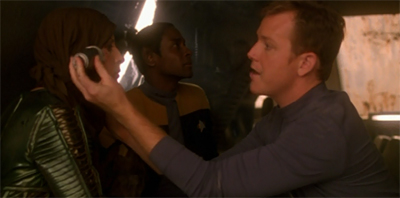
Heated debate.
It is clear that Vulcans do have emotions, they just tend to repress them rather than acknowledge them. The tendency has been to think of Vulcans as something akin to the Fruedian “superego” , an entire species that rises about the emotional fray in order to make rational and dispassionate decisions based on the information to hand. Given Gene Roddenberry’s refactoring of the franchise into something approaching a moral philosophy, it makes sense that this reductive interpretation of the Vulcan psyche would soak through into popular culture.
The characters on the early seasons of Star Trek: The Next Generation often felt like Vulcans. Roddenberry famously banned conflict among the primary cast on the spin-off, leading to the most professional workplace in the history of television . However, in the early episodes of the series, the characters could seem too aloof and too disconnected, too mechanical in nature. It could fairly be argued that the series began to come into its own when the production team allowed Picard to acknowledge his emotions in episodes like Sarek or Family .
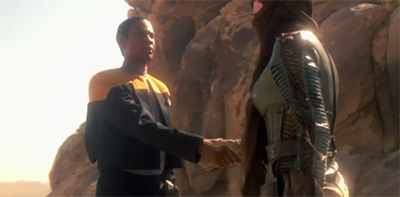
Objects in emotion.
After all, the notion that rational or logical thought can be (or should be) divorced from emotion is a hotly contested psychological theory. This fetishisation of rationality began in the late fifties, and would go unchallenged for decades. Only recently have scientists and psychologists acknowledged emotions are impossible to separate from thought :
Ever since Plato, scholars have drawn a clear distinction between thinking and feeling. Cognitive psychology tended to reinforce this divide: emotions were seen as interfering with cognition; they were the antagonists of reason. Now, building on more than a decade of mounting work, researchers have discovered that it is impossible to understand how we think without understanding how we feel. “Because we subscribed to this false ideal of rational, logical thought, we diminished the importance of everything else,” said Marvin Minsky, a professor at MIT and pioneer of artificial intelligence. “Seeing our emotions as distinct from thinking was really quite disastrous.”
Perhaps this emphasis on rationality was rooted in the fact that many of the researchers and writers working in the field were male , and that the theory was gendered in the same way that some discussions of science-fiction tend to be gendered . Emotions are seen as inherently feminine, and male-dominated arenas tend to react against them .
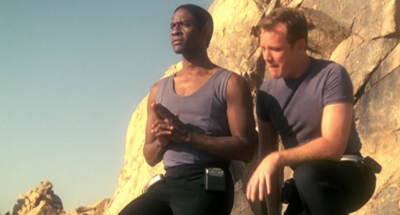
“How can you be so cold on a planet so hot?”
As such, there is something fascinating in exploring the idea of Vulcans as emotionally repressed rather than simply unemotional. After all, the very idea of Amok Time is that storing up all of that emotion leads to a situation where Vulcans need to release the metaphorical safety valve at least once every seven years or risk causing severe harm to themselves and others. Tellingly, Amok Time also suggests that that this emotional safety valve is released through either sec or violence, highly emotional activities.
This suggests a level of nuance and intrigue to the Vulcans, something that extends the species beyond a two-dimensional archetype. It is very similar to the development of other memorable Star Trek aliens like the Klingons or the Ferengi. It is very easy to create an alien species that is built from one core idea, to suggest that the Klingons are “violent” or that the Ferengi are “greedy.” However, it takes more than just an analogy to make an alien species work as a concept. Star Trek features countless failed high-concept aliens from the Kazon to the Son’a to the Suliban.
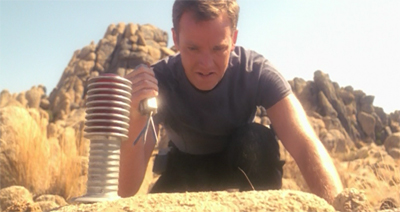
Poking holes in it all.
The best Star Trek aliens are rendered in a way that makes them compelling and intriguing. Klingon culture is not engaging because they are stock “space warrior guys” , it is interesting because of the inherent contradiction that exists at the heart of their culture. Episodes like Heart of Glory , Sins of the Father , The Way of the Warrior , Tacking into the Wind and Judgment cleverly play up the contrast between the image that Klingon culture projects of itself and the reality. The same is true of the contradictions in Ferengi culture suggested by The Jem’Hadar .
Revealing a similar contradiction within the Vulcan psyche adds a layer of nuance to the iconic Star Trek aliens. Many actors on the franchise have struggled to convincingly portray Vulcan characters, with quite a few performers playing the iconic aliens as green-blooded drones. The best actors understand that there is always something happening beneath the cold exterior. Gary Graham did excellent work as Soval on Enterprise , in large part because he understood that subtle undercurrent of emotion in episodes like The Forge .
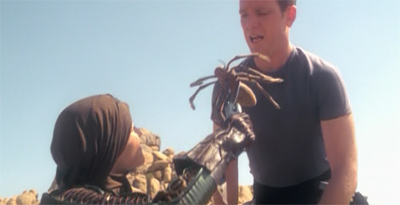
I spi(der) dinner.
Tim Russ acknowledged that this was always a challenge for an actor playing a Vulcan :
Playing the Vulcan character, everything is done very subtly. It’s all about what’s going on under the surface with the Vulcan characters, it’s not on the top … that’s what that whole character is about. Their history is spent basically learning ways in which they control their emotions, so everything is controlled, everything is pushed down as far as any kind of drama or reactions or human-type nature.
The best actors to don the pointy ears suggest vast reservoirs of feeling underneath a calm surface.
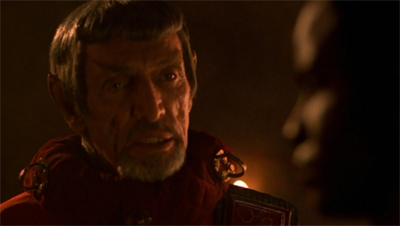
Master his emotions.
Gravity is an episode built around this idea. The episode repeatedly stresses that Vulcans do feel emotions, they just learn to suppress them. “You are surprised to hear a Vulcan master admit to having emotions?” the Vulcan Master teases young! Tuvok in flashback. “Emotions can be a powerful tool. To deny their existence is illogical.” At the very, Vulcans must understand emotions. Tuvok was able to go undercover as a Maquis spy. T’Pring could manipulate Kirk and Spock in Amok Time . Sarek could negotiate with emotional species in Journey to Babel .
However, Gravity goes even further than that. Vulcans do not just acknowledge emotions, they are affected by them. After a heated exchange, Paris tries to clear the air. “Listen,” he states. “What I said in there, about your wife? I’m sorry, I didn’t mean to hurt your feelings.” Tuvok brushes it aside. “I have no feelings for you to hurt.” Paris gets real for a moment with his work colleague. “I think you do,” Paris responds. “You work hard to bury them, but they’re there.” The big question in Gravity is whether Tuvok is lying to Paris and Noss, or to himself.
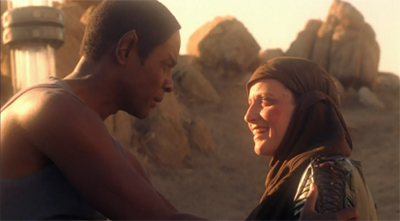
All for Noss.
It is surprising that it has taken the franchise so long to tell a story like this, to explore what it means to be a Vulcan in such a way. Spock was first identified as “part Vulcanian” in Mudd’s Women , meaning that Vulcans predate other iconic Star Trek aliens like the Romulans or the Klingons. However, Vulcan culture has largely been left unexplored beyond quick glimpses of ritual and mysticism in stories like Amok Time , The Motion Picture or Star Trek III: The Search for Spock .
However, it is also surprising that Voyager should be the series to tell this sort of story. After all, Voyager never really developed its alien species. The Kazon were never as fully formed as the Klingons, the Vidiians never as fleshed out as the Jem’Hadar, the Hirogen never as explored as the Ferengi. Voyager tended to treat these civilisations in a superficial manner. Perhaps this superficiality reflected the overarching narrative of the show. Maybe Voyager never invested too much time or energy in its aliens because the crew would just move on the following week.
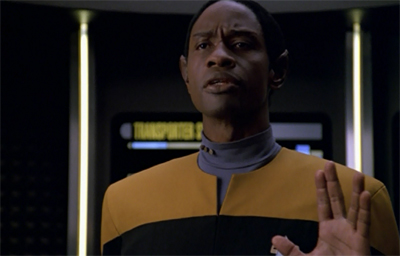
A prosperous career.
More than that, Voyager was a show that very rarely invested in characterisation, even for its major characters. Captain Janeway arguably lacked consistent characterisation across the seven-year run of the show, shifting from a by-the-book commanding officer in stories like Prime Factors and State of Flux to a more gung-ho seat-of-her-pants leader in stories like Night or Infinite Regress . Was Janeway a scientist, a diplomat, or a loose cannon? Voyager never seemed to have a proper answer.
As a rule, Voyager episodes tended to be driven by plot rather than character, more focused on the things that were happening rather than the characters to whom they were happening. Many Voyager episodes often descended into a series of crazy “… and then…” plot developments instead of exploring how the events impacted and informed the characters caught in their midst. This storytelling process could lead to disjointed adventures like Alter Ego or Demon , episodes that seem to burn through several episodes’ worth of story in the space of forty-five minutes.
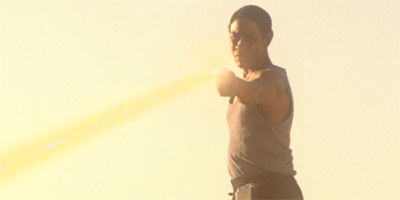
Tuvok ‘n’ roll.
Writer Nick Sagan took the pitch that would become Gravity , and found himself drawn to one central aspect of that idea :
In terms of writing for television, or specifically, for Star Trek, I really think it comes down to the concept. There are so many episodes that have been done before, and you’re trying to break new ground. What I’ve learned is to try to think in abstract terms, even if it’s something close to another Star Trek idea… what is the new, fresh spin on it? What is something that we’ve never seen before? It doesn’t have to be a character or a plot, like with Gravity, it was “emotion creates its own logic”… just something that really tantalises, because if it tantalises you, it probably tantalises the audience.
It is such a simple idea, but it is an idea that has so much potential and intrigue, something that gets at a facet of the Star Trek mythos that has been suggested, but never explored.
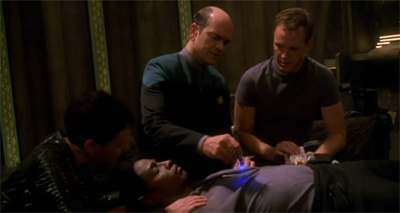
It doesn’t scan.
After all, it is very clear that Tuvok loves his family. He seems to genuinely miss his wife and his children, as evidenced by the impact of T’Pel appearance in stories like Persistence of Vision and Bliss , as well as his response to news of his grandchild’s birth in Hunters . Tuvok’s family is not a logical arrangement, it is not a social unit borne out of convenience. It is a family built upon an emotional attachment that exists. When Tuvok eventually goes through the pon’farr in Body and Soul , he does so with a holographic representation of the woman that he loves.
Gravity explores this contrast between the idea of Tuvok as an emotionally detached individual and as a man capable of love. It is a powerful and compelling paradox, recalling the emotion tug-of-war at the heart of so many classic costume dramas; the battle of repressed emotion and sexuality, an unspoken and unspeakable attraction. “I’ve seen the way you look at her,” Paris admits to Tuvok of Noss. Tuvok shrugs it off. “What way is that?” Paris responds, “Like someone who wishes he wasn’t Vulcan.” Expectations and appearances take a heavy toll.

There is something very pure and very innocent in the dynamic between Tuvok and Noss, playing into sense of repressed romance. There is a recurring conflict in Gravity , between what the characters cannot say, and what they will not say. “I am sorry,” Tuvok warns Noss at one point. “I cannot return your affection.” Noss understands what is being said, even beyond the words that Tuvok has chosen. She inquires, “You cannot, or you will not?” Tuvok answers, “A minor distinction.” It might be a minor distinction, but it is an important one.
Tuvok is defined by what he will not say, what he cannot admit to himself or to anybody else. Paris repeatedly confronts Tuvok about their situation, and Tuvok repeatedly refuses to even acknowledge the complicated emotional situation that is developing. When Paris tries to figure out what happened between Tuvok and Noss, Tuvok shuts him down. “Our conversation was private.” When Paris wonders what made Tuvok so repressed, Tuvok advises him, “I have no intention of continuing this conversation any further.”
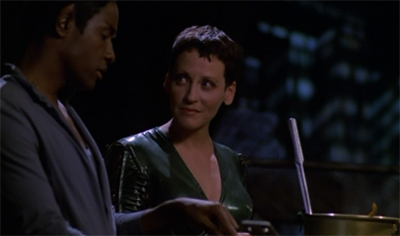
Food for thought.
Tuvok’s unwillingness to express himself is thematically juxtaposed with Noss’ struggle to find the right words. With the universal translator broken, Noss is forced to learn English to express herself. She speaks in broken English, often searching for the right word and shoe-horning in a clumsy fit to get her point across. One early exchange is revealing. As Paris talks about Torres, Noss responds, “You must really… baiya jouton?” The EMH translates, “Love her very much.” Despite literally not speaking English , Noss still expresses herself better than Tuvok.
There is an endearing earnestness to the dynamic between Tuvok and Noss. Without a common language, Noss still finds a way to communicate what is truly important. As Tuvok tells her about Voyager, she presses, “Tell me about you there.” Tuvok responds, “I am the Chief Tactical Officer.” Noss asks, “What else?” Tuvok doesn’t understand. “Can you be more specific?” Noss struggles for words. “Your duties. Where you sleep. What you eat. Music. Friends.” Tuvok is puzzled. “Why is any of that relevant?” Noss knows exactly what she means. “Because it is you.”
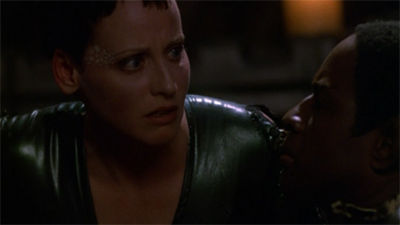
To be or Noss to be.
That is one of the most compelling and beautifully expressions of romance in the fifty-year history of the franchise. It is a beautiful distillation of what it means to have a romantic interest in someone, to the point where even the most mundane details of their day-to-day life are compelling by association. It is a small moment that effortlessly captures the curiosity of such romance, the intrigue and the excitement. More than that, all of it comes from a character who is speaking in broken English to a stranger she has only known for a few days.
As with Counterpoint earlier in the season, Gravity is an episode that is built very well from the ground up. It has an interesting premise, a character-driven focus, a superb guest performance, and a number of very clever ideas that are never allowed to eclipse the core appeal of the story being told. A lesser episode would make a bigger deal of the time dilatation inside the anomaly of the week, using it as a slingshot to some bolder high-concept story about time. Blink of an Eye would recycle the premise for a more concept-driven episode, but Gravity is never distracted by it.
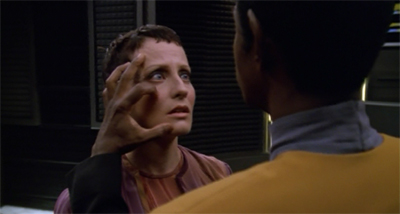
Getting into one another’s heads.
All of the elements in Gravity just come together very well. As Tim Russ explained to Cinefantastique , it was a story when all of the elements seemed to align almost perfectly:
“Gravity was a really big show. We had to go on location for two days. We rarely ever go on location, not more than maybe a couple of times a year. It was fabulous. We were out in Palmdale, in the high desert, and it was actually pleasant. Lori Petty is a very good actress, and did a fine job. Robert Duncan McNeill and I have worked together quite a bit in the last couple of years, and it’s always a lot of fun, because we do a lot of cutting up.” Russ continued, “I thought it was shot well, and the opticals came together nicely. I was very happy with it. It was an enlightening episode for the character, a chance to peek back at his past, and see him as a child, see what he went through at that age and the kind of legacy that he left behind. It was a very eye-opening show.”
These stories are relatively rare on Voyager , largely down to a combination of the troubled production and the recurring structural weaknesses of the series. However, Gravity flows perfectly.
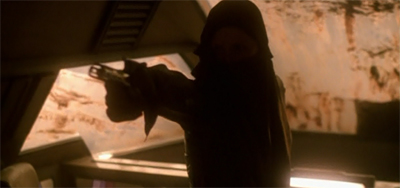
In some ways, Gravity counts among the most influential episodes of Voyager . Its exploration of Vulcan psychology has an outsized impact. A lot of the characterisation of Spock in Star Trek and Star Trek Into Darkness builds upon ideas suggested in Gravity . Like the adolescent Tuvok who features in Gravity , the rebooted version of Spock is presented as a highly emotional young Vulcan whose tendency towards passion causes severe problems for his family and his future.
More than that, both Star Trek and Into Darkness make a point to emphasis fact that Vulcans do feel emotions, underneath it all. Early in Star Trek , Spock asks his father why he would choose to marry a human woman. “Marrying your mother was logical,” Sarek responds. Later in the movie, as Spock finds himself in crisis, Sarek revisits that conversation. “You asked me once why I married your mother. I married her because I loved her.” It is a very simple answer, but also very effective.
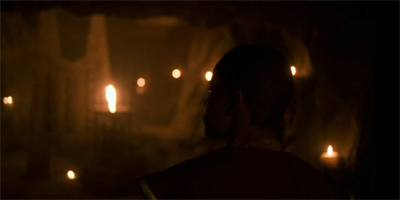
Will Tuvok cave under the pressure?
Similarly, the relationship between Spock and Uhura runs into difficulty in Into Darkness when Uhura struggles with Spock’s inability to express his feelings, claiming that he does not care. Spock responds, “Nyota, you mistake my choice not to feel as a reflection of my not caring. Well, I assure you, the truth is precisely the opposite.” The suggestion is that Spock simply cares too much, that his emotions run deep and exert their own gravity upon his character. While this obviously builds on the work of Leonard Nimoy, it feels very much of a piece with Gravity .
It should be noted that even the background plot of Gravity would evolve into a franchise favourite. The Star Trek franchise had always been fond of stranding characters on strange and hostile worlds, dating back to episodes like The Galileo Seven or Metamorphosis . In many ways, Gravity is a continuation of that particular plot trend. The episode is a spiritual successor to other classic “shuttlepod down” stories like Parturition , Innocence , Rise or Nemesis . However, it also seems to represent something of a pivot point.
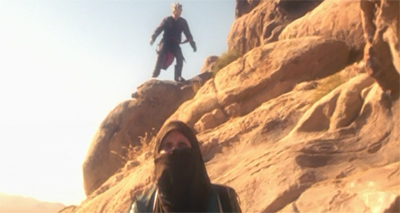
A rocky road to friendship.
Gravity is a story about characters who find themselves thrown into a hostile and almost Darwinist environment in which the strong prey on the weak. Noss steals supplies from Paris, and is then ambushed by two other aliens. “They were attempting to rob her,” Tuvok explains. Paris deadpans, “Seems to be a local pastime.” The Starfleet officers encounter a culture of violence, in which people have learned to fend for themselves. Noss has “been alone for many years” , maybe as many as “fourteen seasons.” That time alone has forced her to prey on those weaker than her.
However, Noss is redeemed by the protagonists. She is introduced as a bandit robbing medical supplies from the shuttle, but the climax of the episode finds her risking her own life so that her friends might return home. There is a sense that the values of the Federation are infectious and appealing, that being around Tuvok and Paris (and the EMH) is enough to empower Noss to become a better person – maybe even to be the person that she was before this tragedy happened, stranding her alone on this hostile world.

Don’t force(field) it.
This would becomes a recurring theme in later Star Trek stories. Voyager revisits it in The Void , when the ship finds itself thrown into a hostile environment and is forced to assemble a mutually beneficial alliance between those communities that have found themselves trapped in the same situation. Janeway effectively builds herself a miniature Delta Quadrant version of the Federation from bands of scavengers and predators. Gravity does not feature the same level of alliance-building or enabling, but it is very much a factor.
Similarly, the plot of Star Trek Beyond owes something to Gravity . Once again, the primary characters find themselves stranded on a hostile planet surrounded by predators who operate according to Darwinian logic. Beyond is much more specific in the cues that it borrows from Gravity . Montgomery Scott comes face-to-face with an orphaned young woman who speaks broken English, who has been forced to do violent things to protect herself and the shelter that she has built. She helps the crew escape, and they take her with them.
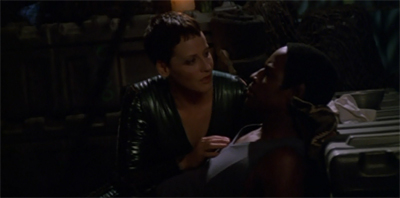
Only his pride has been injured. And his body.
It is strange to think of this fifth-season episode of Voyager having such a large impact on the future direction of the franchise. Gravity is hardly the most beloved or most high-profile of fifth season entries. It lacks the sense of scale that defined Timeless or Dark Frontier, Part I and Dark Frontier, Part II . It lacks the sense of import that defines Equinox, Part I . Lori Petty is a pretty impressive guest star, but she is probably less recognisable than Jason Alexander in Think Tank .
The fact that Gravity seems to foreshadow so much of what will come is a testament to how well constructed it is as an episode of television. It is an episode that demonstrates the potential of the Voyager ensemble, proving that it is possible to tell compelling character-driven narratives centred on cast members who have been largely overlooked and ignored. Timeless proved that there was at least one interesting story to be built around Harry Kim. Gravity illustrates how intriguing Tuvok might be, were he allowed to develop.

“Do you smell what the rocks are cooking?”
Even the supporting cast is used well in Gravity . Tuvok is trapped on the planet surface with Paris, which provides a dynamic that works surprisingly well. Robert Duncan McNeill expressed a fondness for that pairing in an interview with Cinefantastique :
I love working with Tim. One of my favorite combinations, in terms of characters, is Tuvok and Paris. I just think they are hilarious. They are such opposites, and they can dig at each other in such a light, fun way, I think they make a great team. We got to have all the subtle, fun jokes with each other. I thought it was particularly well-written, and I thought our guest star, Lori Petty, was great. It was great to be out on location. When you get on location, you feel you are making a real movie.
Indeed, Gravity would not work near as well if the writers had substituted Robert Beltran or Garrett Wang into that supporting role with Tim Russ. Roxann Dawson might have provided an interesting edge, but it would have been a very different dynamic than the one that exists between Russ and McNeill.
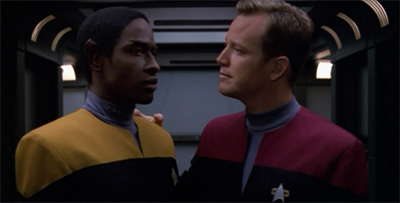
“Now, let’s never speak of this again.”
The combination of Tuvok and Paris has become on of the more subtly effective team-ups among the Voyager ensemble. The two worked undercover together in Future’s End, Part I and Future’s End, Part II , before writing a holonovel together in Worst Case Scenario . Even their smaller scenes together work well in Extreme Risk or Bride of Chaotica! Tuvok is a much more compelling foil for Paris than Kim. Paris is a much more interesting contrast for Tuvok than Neelix.
There are any number of reasons why this pairing works so well. Russ and McNeill bounce off one another with a great deal of skill, bringing out the best in one another. The characters also mirror one another very effectively. Both Tuvok and Paris exist apart from both the Starfleet and the Maquis crew. Paris was a Starfleet dropout who joined the Maquis and quickly got himself arrested. Tuvok was a Starfleet officer who infiltrated the Maquis in order to turn them over to the authorities. Tuvok is cold and rational, while Paris is characterised as highly emotional.
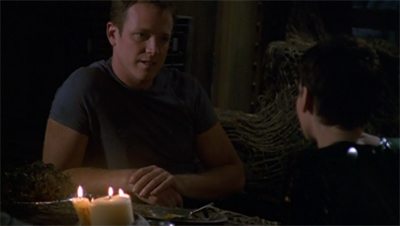
His torrid Torres love affair.
On any other television show, the production team would have acknowledged that these two characters worked well together and made a point to develop a relationship between them. This is how the writers working on Star Trek: Deep Space Nine tended to approach long-form characterisation, bouncing actors off screen partners in an effort to properly calibrate the characters and the dynamics to build an engaging ensemble. A lot of the character dynamics on Deep Space Nine were improvised, drawn from the actors’ performances and strengths.
Voyager never seemed to pay that much attention to their cast. While Deep Space Nine spent three full seasons trying to figure out how to make Julian Bashir and Jadzia Dax work, Voyager gave up on Chakotay and Harry Kim after only two years. Voyager should have figured out that Tuvok and Paris played well together much earlier in the run, but it does not matter. Voyager never had any interest in developing its characters to play to the strengths of the cast. The strangely compelling interplay between Tuvok and Paris would remain a background detail.
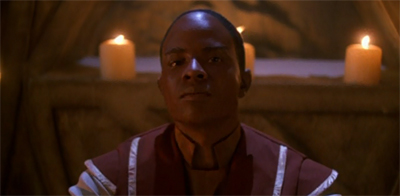
A long time again, in a galaxy just outside this sinkhole.
In some respects, then, the gravity well feels like an appropriate metaphor for Voyager as a television show. It is a phenomenon that compresses time. Characters remain stuck inside for what feels like an eternity, with no real movement or development. As much as Voyager was a show charting a linear course back to the safety of the Alpha Quadrant, there was never a sense of momentum. After all, there was never any sense of the passage of time and the growth that comes with that.
Many of the characters on Voyager seemed to fall into their own quantum sinkholes, with their own distorted sense of time. Tom Paris might have a relatively complete character arc from Caretaker to Endgame , but what about Harry Kim? Paris could be demoted to ensign and promoted to lieutenant, while Kim was still standing in place. Time moved faster for some characters than for others, affording opportunities for development and change. Gravity finally offers Tuvok such a chance. Unfortunately, he has to fall out of the universe in order to grasp it.
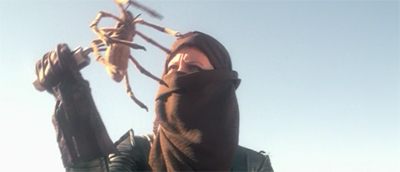
On its last legs.
Still, Gravity is an impressive accomplishment, even if the franchise would not deliver on its potential until long after Voyager had ended.
Share this:
Filed under: Voyager | Tagged: Bryan Fuller , emotions , lori petty , love , nick sagan , rationality , star trek , star trek: voyager , tuvok , Vulcans |
8 Responses
Hey, I recognize the costume on Tank Girl. It’s the same worn by the female plant workers in “Workforce”.
Yeah, the budget does seem to be entering the contraction phase around this point in the run.
Quite the impressive ‘thesis’, not only of the episode, but the full series… as both a film student & 28 year vet of the biz, this is quite fairly appreciated, & further fulfilling having grown up with all the Trek series & films, as well as even having participated in some of the Trek franchise… That said, it must certainly be noted that with such a very compellingly, fully fleshed out ‘disertatative review’, further worthy mention of the very distinguished actor Joseph Ruskin’s Vulcan Master portrayal was somewhat overlooked; some decently worthy analysis was given, but overlooked the appropriate notation of this very unique & iconic actor’s reappearance in the series, as was indeed noted in a tribute statement by the Screen Actors Guild upon his passing at the end of ’13: “One of only a handful of actors brought back for successive entries in the “Star Trek” franchise, he appeared in the original series, three of the four successor series, the feature film “Star Trek: Insurrection,” and two Star Trek video games.” …All due respect that this was essentially an episode review, but having gone to such extensive lengths of analysis, this was most certainly a worthy highlight to be included. …most Trekkies would most likely agree, yet logically well done otherwise👌🏽🎬
That’s probably fair. Ruskin is great, as he is in all of his Star Trek roles. A great presence. (And a fantastic voice.)
“Unfortunately, he has to fall out of the universe in order to grasp it.” – Good line!
Thanks for this insightful review. Never caught this episode to be as good as it was on my rewatch, and my higher than before appreciation for this show was in no small measure aided by your favorable reading of the episode. Having aged a bit and found “Eastern spirituality” in a broad sense much more interesting and compelling than 20 years ago I really could watch this show in a different way than before. It might be true that this was one of the pivotal episodes to change the notion or sentiment of Vulcans “genetically” unemotional.
I am quite astonished how good Voyager actually was at times. I tended to follow the ciritcal fan’s average downgrading of it in recent years, but come to think of it or to see it all again, I am quite impressed about the overall quality of it. Maybe I am blinded by nostalgia – I am not sure…
Yep. There are some circles of online fandom that think I’m unduly harsh about Voyager , and I do rake it over the coals when it deserves it. But I think it’s clear from this run of four episodes that I loved Voyager as much as anything when it was its best self. And Gravity (along with Counterpoint ) is very much Voyager ‘s best self.
This is easily one of the top 5 Voyager episodes in my book.
The ending seals it though. So nice to see Tuvok get a decent episode for once. The dialogue between young Tuvok and the Vulcan master is also fairly well done for Trek. It’s a pity we didn’t see more of this kind of stuff, more cultural development for races, and characters like Tuvok.
This episode is often overlooked by Voyager vans for the more flashy shooty action ones.
Leave a comment Cancel reply
This site uses Akismet to reduce spam. Learn how your comment data is processed .
Recent Posts
- 373. Pirates of the Caribbean: The Curse of the Black Pearl (#225)
- 371. Poor Things (#246)
- 370. Dune: Part Two (#12)
- 369. Memento (#57)
- 368. Monty Python and the Holy Grail (#154)
Recently tweeted…
- "I Simply Am Not There": The Existential Horror of Eighties Excess in "American Psycho"...
- X-Men: Operation Zero Tolerance (Review/Retrospective)
- Star Trek: Voyager (Reviews)
- Adding Our RSS Feed to Your Gmail
Available at…

Blogs Well Worth Your Time
- 1001 Must See Films
- Andrew at the Movies
- Anomalous Material
- Cut the Crap Movie Reviews
- Encore Entertainment
- Fandango Groovers
- FlixChatter
- Four of Them
- It Rains… You get Wet…
- Jameson Cult Film Blog
- Jar Watches Films
- Let's Go To The Movies
- M. Carter at the Movies
- Marshall and the Movies
- Movie News First
- Musings from a Man Lost in La Mancha
- Never Mind Pop Film
- Paragraph Film Reviews
- Roger Ebert's Journal
- Ross v. Ross
- Scannain.com
- Screenwriter (Donald Clarke, Irish Times)
- Strange Culture
- The Film Cynics
- The Pompous Film Snob
- The Projection Booth
- Things That Don't Suck
- Too Busy Thinking About My Comics
- Undy a Hundy
Film Nerd Resources
- CinemaBlend (News)
- Internet Movie Database
- Rope of Silicon
- The Guardian Film Blog
- James Berardinelli
- Roger Ebert
Email Subscription
Enter your email address to follow this blog and receive notifications of new posts by email.
Email Address:
Sign me up!
Blog at WordPress.com. WP Designer.
- Already have a WordPress.com account? Log in now.
- Subscribe Subscribed
- Copy shortlink
- Report this content
- View post in Reader
- Manage subscriptions
- Collapse this bar

- USS Voyager personnel
- Maquis personnel
- View history
Seska was a female Cardassian operative of the 24th century Cardassian Union . On one fateful mission, she was genetically altered to appear Bajoran in order to infiltrate the Maquis on the Val Jean under Chakotay , and use her relationship with him to steal Maquis secrets. However, she was forced to join the crew of the USS Voyager when it and the Val Jean were stranded in the Delta Quadrant . Unwilling to live by Starfleet rules, she later left to join with a Kazon , Culluh , in an unsuccessful attempt to capture Voyager . ( VOY : " State of Flux ", " Maneuvers ", " Basics, Part I ", " Basics, Part II ", " Worst Case Scenario ")
- 1.1 The Maquis and USS Voyager
- 1.2 Collaboration with the Kazon
- 1.3 Hologram
- 2.1 Chakotay
- 2.2 B'Elanna Torres
- 3 Personality and traits
- 4.1 Appearances
- 4.2 Background information
- 4.3 Apocrypha
- 4.4 External links
History [ ]
The maquis and uss voyager [ ].
Seska first joined the Maquis in 2370 while undercover for the Cardassian Union . ( VOY : " State of Flux ")
She served under Chakotay aboard the Maquis raider Val Jean when it was catapulted into the Delta Quadrant by the Caretaker 's array in 2371 . ( VOY : " Caretaker ") She was close friends with B'Elanna Torres and on Voyager was granted the field commission of Ensign , initially in the science department but later moving to engineering . Not very fond of the Federation , Starfleet , and their "mighty principles", she often expressed her disapproval and annoyance with their rules and made it clear to Chakotay that if the situation ever necessitated it, she would support a Maquis mutiny . ( VOY : " Caretaker ", " Parallax ", " Prime Factors ")
She was involved with Lieutenants Torres, Joe Carey , and Tuvok in a covert attempts to acquire spatial trajector technology from the Sikarians , behind Captain Janeway 's back. When their plan to steal the technology failed, she attempted a cover-up, but Torres held her back, stating that she did not want to lie anymore – something Seska found rather disappointing. ( VOY : " Prime Factors ")
Her disdain of Starfleet and Starfleet principles, such as the Prime Directive , led to her distancing herself from the crew further, ultimately leading to collaboration with the Kazon-Nistrim , offering them replicator technology in exchange for their help in this unknown part of the galaxy . She did not believe it mattered if something simple like replicator technology might shift the balance of power in this part of the quadrant , and she believed the primary goal should be to get back home and that was all that mattered. ( VOY : " State of Flux ")
Her true origins remained undiscovered until the time she helped transfer replicator technology to the Nistrim and was seriously injured during an attempt to cover-up her involvement in the transfer. The Doctor 's subsequent examination revealed her to actually be a Cardassian altered to look Bajoran. Seska denied this, claiming that she had suffered from Orkett's disease as a child and received a bone marrow transplant from a Cardassian woman named Kattell to survive. When Chakotay confronted her, revealing the cover-up, she finally confessed to everything and openly expressed her dislike for Captain Janeway's decision, calling her a fool for having gotten Voyager stranded in the Delta Quadrant, Janeway being unwilling to give the Kazon what they wanted so that Voyager could have a powerful ally in the Delta Quadrant. Seska also expressed her disappointment in Chakotay, whom she believed naively followed Janeway, and stated that she couldn't imagine why she had ever loved him. Before she could be further questioned, she escaped Voyager by transferring to a Kazon raider . ( VOY : " State of Flux ")
Collaboration with the Kazon [ ]
After leaving Voyager , Seska immediately restored some elements of her Cardassian physiology and became the consort of First Maje Culluh , leader of the Kazon-Nistrim sect. Culluh had a thirst for power and she used that to manipulate him to do what she wanted. Equipped with Starfleet, Maquis, and Cardassian tactical experience, she provided the Nistrim with information about Voyager and schemed ways of stealing the ship and its technology.
In order to capture Chakotay, she planned a successful attempt to steal a transporter control module from Voyager , knowing that he would come after it. Even though Chakotay was able to destroy the module, he was captured and heavily beaten during interrogation. During his capture, Seska tried to get close to Chakotay but he rejected her advances, later laughing at Culluh, telling him that when Seska was through with him, she would kill him.
Shortly after Chakotay was rescued, Seska contacted him, claiming that she had impregnated herself by extracting his DNA and that she was carrying his child . At the same time, she had also told Culluh that the child belonged to him, thus using the baby to manipulate both men. ( VOY : " Maneuvers ")
Later that year, she and Culluh were contacted by Janeway and her crew who proposed building an alliance with the Nistrim in exchange for providing them with emergency supplies where needed. Culluh – who did not want a woman to dictate the terms of the agreement – insisted on a crew exchange as condition of the alliance; a proposal Janeway found unacceptable, resulting in the end of further negotiations. When Voyager formed an alliance with the Trabe – an enemy of the Kazon – instead, Seska was angered, accusing Culluh of having let Voyager slip away because of his attitude, which she promised would one day be his undoing. Even though Culluh did not like being talked to like that by a woman, she always managed to manipulate him to look the other way and acquiesce to her demands and scheming. ( VOY : " Alliances ")
Seska was not the only one disillusioned with Captain Janeway's policies: Voyager crewmember Michael Jonas also appeared to harbor resentment towards the Starfleet policies he had to live by and soon after Seska left, he contacted her, offering to collaborate with her and help sabotage the ship by supplying her and the Nistrim with vital information pertaining to Voyager . However, Janeway and Tuvok discovered Jonas' transmissions and through an elaborate plan were able to expose him. ( VOY : " Lifesigns ", " Investigations ")
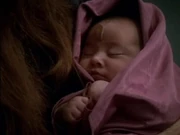
Seska's baby
In late 2372 , Seska gave birth to the child she claimed to be Chakotay's. She immediately contacted him, claiming that Culluh had discovered that the child was not his and threatened to have the child be raised as a slave . This lured Voyager into a trap in which a Kazon operative named Teirna was able to enter the ship and detonate organic explosives in his bloodstream while on board, disabling the ship's power systems and the primary computer core . Janeway was unable to activate the auto-destruct sequence in time and the ship was boarded by Kazon troops. Soon after Seska and Culluh took over the ship, they marooned its crew on a desolate planet named Hanon IV .
During the Kazon occupation of the ship, Seska took stringent precautions against any possible threats, even questioning The Doctor's loyalty. That line of questioning was cut short when he revealed through a DNA analysis that her baby was actually half-Kazon, not half- Human , and thus not Chakotay's. This greatly disappointed Seska, who had been sure that the baby was half-Human and was hoping to forever trap Chakotay by her side.
After taking over the ship, Seska and Culluh did not get very far, however, as most of the Kazon were ill-equipped to navigate and control the ship's complex and unfamiliar technology. In addition, Tom Paris – who had left Voyager in a shuttle prior to the Kazon attack to seek help – with assistance from Talaxian forces, as well as The Doctor and Lon Suder , was able to retake the ship. During the mission to recapture Voyager , Seska was mortally wounded in the resulting overload of the console she was at and only had a few minutes to live. She collapsed and died reaching for her baby. Culluh discovered her body and escaped with their son just before the crew returned. ( VOY : " Basics, Part I ", " Basics, Part II ")
In 2377 , a temporal distortion shifted sections of Voyager into different timeframes with Chakotay being the only one capable of traveling between timeframes, unaffected by the temporal distortion after being given a chroniton -infused serum by The Doctor. One of the areas he visited was engineering during the Kazon-Nistrim takeover of the ship in 2372, where he encountered Seska and a number of Kazon trying to gain control of the ship after Engineering was isolated from the rest of Voyager . Although he was forced to tell Seska the truth about what had happened to try and restore Voyager to normal, when Seska learned that the Kazon were defeated in their efforts, she attempted to stop Chakotay's efforts to restore the timeframe, holding a past version of Janeway hostage to try and make him modify the plan to return Voyager to her time, hoping that she could use this new foreknowledge to avert the crew's efforts to take back the ship. However, these plans failed thanks to the intervention of various allies Janeway and Chakotay had recruited from other time periods – such as future versions of Icheb and Naomi Wildman or a still- Borg Seven of Nine – and Voyager was successfully restored to its original configuration in the correct timeline, erasing Seska's memory of her encounter with the future Chakotay. ( VOY : " Shattered ")
Hologram [ ]
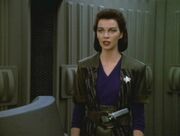
Hologram of Seska
At some point in the early days of Voyager 's journey through the Delta Quadrant, Tuvok had created a holodeck training simulation program called " Insurrection Alpha " depicting a Maquis mutiny. At the beginning of their journey, he had perceived such a rebellion to be a very real threat and had devised a program to train Starfleet personnel in case of such a contingency. However, when he realized that the two crews were getting along better than anticipated, he deleted the program and never told anyone about it, fearing that it would trigger the very mutiny he wanted to avoid. At some point, Seska had discovered the unfinished program, which ended with Janeway and Paris returning from an away mission and beginning their attempts to retake the ship. Seska secretly reprogrammed it to act as a trap, arranging for the program to essentially 'turn' on Tuvok should he reactivate the narrative parameters file (i.e. attempt to edit the program). Over a year after Seska's death , the program was discovered by Torres and played several dozen times by various crewmembers, who found the story line very intriguing. When Tuvok and Tom Paris attempted to alter the program by writing an ending for it, Seska's trap was triggered and both men became trapped in the holoprogram with the safety protocols off. However, Captain Janeway was able to reprogram portions of the simulation to allow Tuvok and Paris to escape, simultaneously causing the "death" of the holographic Seska after giving Tuvok the chance to program a phaser rifle Seska was using to overload. ( VOY : " Worst Case Scenario ")
Personal relationships [ ]
Chakotay [ ].
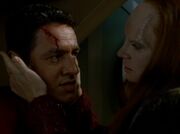
Seska "questioning" Chakotay
Seska and Chakotay were romantically involved sometime in the past, although they had eventually decided not to pursue their relationship any further. However, a certain attraction between the two still existed and when Chakotay once reminded Seska of their decision to not be together anymore, she laughed it off, joking that stranded in the Delta Quadrant, he didn't have all that many options. Despite being hesitant to pursue a romantic relationship with her, Chakotay nonetheless had a soft spot for Seska and when she was accused of sabotage and collaboration with the enemy, he was the only one taking her side until the truth about her betrayal came out. Chakotay was devastated to find that not only had she collaborated with the Kazon but that in fact she was a Cardassian spy. Even though she insisted that she had truly loved him and was not after his meager Maquis secret, he still felt betrayed. Shortly after she was exposed and before her departure from Voyager , she expressed her deep disappointment in Chakotay who had decided to take on the kind of "mighty Starfleet principles" she abhorred and believed to be a hindrance to their efforts to find a way back home. She wondered how she could ever have loved him and shortly after beamed off the ship. ( VOY : " State of Flux ")
After this betrayal by Seska, Chakotay felt a great sense of shame and disappointment, because she had not only taken advantage of his trust but also because after everything he had done for her, she publicly humiliated him by turning out to have been a Cardassian spy who now had, once again, turned her back on him by defecting to the enemy.
Seska's infatuation and obsession with Chakotay did not end after her departure and she resorted to any manipulation possible to bring him to her, such as the time she lured him into a trap in which he was caught and tortured by Culluh and his men unsuccessfully for information about Voyager . She also used that opportunity to impregnate herself by extracting Chakotay's DNA. After the baby was born, she once again lured him to her side by pretending that the child was in danger. Unable to abandon his child, Chakotay – as soon as he found out – pursued her, a pursuit that led to the capture of the Voyager by the Nistrim and to the crew being marooned on Hanon IV. Although The Doctor determined that the child was not Chakotay's son, even after Seska was killed when Paris and the Talaxians managed to retake the ship, Chakotay still seemed to be affected by his memories of their old relationship. ( VOY : " Maneuvers ", " Basics, Part I ", " Basics, Part II ")
When Seska had found Tuvok's Insurrection Alpha holonovel training program depicting a Maquis mutiny and reprogrammed it with the goal of trapping whoever played it into the program, she had programmed the novel to portray a holographic Chakotay to be strongly enamored by her, and the two were enthusiastically living out their old wild Maquis ways the way Seska had always pictured and dreamed it would be. ( VOY : " Worst Case Scenario ")
When the Chakotay of 2377 found himself on Voyager during the Kazon control of the ship, he initially attempted to appeal to Seska by simply telling her what had happened, but when Seska tried to seduce and then force him to restore Voyager to her time period, Chakotay turned the tables on her by summoning other allies to aid him in retaking the ship, showing that he had moved on from any residual affection he had for her. ( VOY : " Shattered ")
B'Elanna Torres [ ]
B'Elanna Torres and Seska were somewhat kindred spirits not too unfamiliar with the strong emotions that come with anger. Both had also served in the Maquis under Chakotay's command and up until Seska's betrayal, they were good friends. At some point it even looked like Seska was warming up to the Starfleet crew, such as the time she and B'Elanna were joking with and teasing young Harry Kim about his disastrous date with one of the Delaney sisters on the holodeck.
However, unlike Torres who did make efforts to integrate into the crew, Seska rejected all that and chose a life more in tune with her Cardassian background. Torres pursued the spatial trajector technology of the Sikarians after Seska manipulated her to feel sorry for her now that she could not see her brother on his birthday on Nivoch as promised. When their plan backfired, Seska wanted to cover everything up by deleting all evidence leading to them. Torres held her back, saying that she was no longer going to lie and instead would take responsibility for her actions; a move that left Seska disappointed in Torres, accusing her of "having changed." Torres viewed the change Seska mentioned as a compliment and even though she did feel betrayed after the truth about Seska came out, unlike Chakotay – she was able to put it behind her. ( VOY : " Prime Factors ", " Maneuvers ")
Personality and traits [ ]
Seska was one of many Maquis who had trouble abiding by Starfleet regulations, though she initially tried to adjust to being a part of Janeway's crew. She made friends with both Tom Paris and Harry Kim while serving on Voyager and enjoyed a laugh at Harry's expense after hearing of their double date, seemingly enjoying herself while in their company.
She was one of many Maquis who tried to sway Chakotay into taking over Voyager and was shocked when he threatened to put her and another Maquis into the brig if they talked about it again. Her frustrations continued to grow when Janeway refused to take advantage of the people of Sikaris by using their advanced transport technology.
Her anger towards her came to a head when she was discovered to have given their replicator technology to the Kazon, blaming Janeway for their failed attempts to get home and calling her a weak leader before defecting to the Kazon.
Appendices [ ]
Appearances [ ].
- " Parallax " (Season One)
- " Emanations "
- " Prime Factors "
- " State of Flux "
- " Maneuvers " (Season Two)
- " Alliances "
- " Lifesigns "
- " Investigations "
- " Basics, Part I "
- " Basics, Part II " (Season Three)
- " Worst Case Scenario " (as a hologram)
- " Shattered " (Season Seven) (alternate timeline)
Background information [ ]
Seska was played by actress Martha Hackett .

Seska's rank insignia
Although Seska was invariably referred to as "ensign" during her appearances in uniform, she wore the provisional rank insignia of crewman (one hollow stripe). Contrarily, she was referred to as " Commander Seska" by Seven of Nine in VOY : " The Voyager Conspiracy ", however, Seven's clarity at the time had clearly been compromised.
In 2002 , Seska placed eighteenth in TV Zone 's list of the top twenty science fiction television villains. The Borg Queen was second, Dukat was fourth, Weyoun was eighth, and Q was eleventh.
Seska's true intentions in helping the Kazon-Nistrim were never explicitly revealed, though she initially claimed that by helping them, she would be helping Voyager gain a protective ally. ( VOY : " State of Flux ")
Apocrypha [ ]
In the Voyager novella "The Third Artifact", part of The Brave and the Bold, Book Two , Seska's past as an undercover agent for the Cardassian Empire is explored. In there, Seska had been made an intelligence operative for the Obsidian Order in 2361 and by 2367 , she underwent surgical operations to transform her Cardassian physiology into that of a Bajoran so she could infiltrate the Bajoran Resistance . After the Occupation of Bajor ended in 2369 , Seska was assigned to spy on the Maquis.
Her mirror universe counterpart ( β ) appeared in the novella " The Mirror-Scaled Serpent " and the novel Rise Like Lions . She was a Cardassian glinn serving in the Klingon-Cardassian Alliance who defected to the Terran Rebellion prior to 2371 . She was killed in Rise Like Lions .
External links [ ]
- Seska at StarTrek.com
- Seska at Memory Beta , the wiki for licensed Star Trek works
- Seska at Wikipedia
Screen Rant
Star trek: voyager & ds9 crossed over in the mirror universe.
Despite being stuck in the Delta Quadrant, a Star Trek: Voyager crew member briefly crossed over into the Mirror Universe to join the DS9 cast.
- Star Trek: Voyager and Deep Space Nine crossed over within the Mirror Universe, bringing the shows together across vast cosmic distances.
- The crossovers featuring characters like Tuvok and Doctor Zimmerman added depth to the interconnected Star Trek universe.
- Despite differing tones, Voyager and DS9 remain beloved shows, delighting audiences through streaming platforms today.
Despite being separated by thousands of light years, Star Trek: Voyager and Star Trek: Deep Space Nine crossed over inside the Mirror Universe. Voyager and Deep Space Nine were very different in tone, due to the differing approaches of the shows' respective producers, Brannon Braga and Ira Steven Behr. Where DS9 was a serialized drama that tackled huge themes, Voyager embraced a traditional episodic approach that could sometimes feel disposable and regressive . Despite their differences in tone, DS9 and Voyager are two beloved Star Trek TV shows that still delight audiences to this day via streaming, which is a testament to the versatility and timelessness of the franchise.
As the USS Voyager was stranded in the Delta Quadrant, it was hard, but not impossible, for Star Trek: Voyager to cross over into Star Trek: Deep Space Nine 's Alpha and Gamma Quadrant settings. In fact, there was a surprising number of Star Trek characters who guested on Voyager from Captain Hikaru Sulu (George Takei) to Commander William T. Riker (Jonathan Frakes). Creative approaches such as intervention by Q (John de Lancie), glimpses of Starfleet's attempts to locate the missing USS Voyager, and even the Mirror Universe allowed Star Trek: Voyager to crossover with its 1990s contemporaries, including Star Trek: Deep Space Nine .
Every 1990s Era Star Trek Crossover
Star trek: voyager’s tuvok crossed over with ds9’s mirror universe, star trek: deep space nine, season 3, episode 19, "through the looking glass".
In Star Trek: Deep Space Nine season 3, episode 19, "Through the Looking Glass", Commander Benjamin Sisko (Avery Brooks) is captured and taken to the Mirror Universe by "Smiley" O'Brien (Colm Meaney). The Rebellion in the Mirror Universe wanted Prime Sisko to convince the ex-wife of his Terran counterpart to join the resistance against the Klingon-Cardassian Alliance . As Sisko is taken to the Terran Rebellion's enclave, he meets the Mirror Universe variants of his DS9 crew mates. In the same scene Sisko also meets the Mirror Universe version of Star Trek: Voyager 's Lt. Tuvok (Tim Russ), leading a more logic-driven faction of the Rebellion.
Mirror Tuvok is the only Mirror Universe variant of a Star Trek: Voyager character that has appeared on TV.
Tuvok was included in "Through the Looking Glass" at the request of Rick Berman , who presumably wanted to strengthen the links between Star Trek: Deep Space Nine and Star Trek: Voyager . DS9 season 3 and Voyager season 1 aired concurrently with each other, and "Through the Looking Glass" aired on April 17, 1995, a week when there was no new episode of Voyager . In this gap between "State of Flux" and "Heroes and Demons", therefore, a brief crossover between Voyager and DS9 was a good way to keep the fledgling Star Trek show in the minds of the audience.
Every Voyager & DS9 Star Trek Crossover
"Through the Looking Glass" isn't the only crossover between Star Trek: Voyager and Star Trek: Deep Space Nine . The Voyager pilot "Caretaker" features the USS Voyager depart from Deep Space Nine to search for the missing Tuvok and the Maquis ship, the Valjean in the Badlands. As with McCoy and Picard in the previous Star Trek pilots, DS9 's Quark (Armin Shimerman) appeared in "Caretaker" to pass the baton to Voyager . In a scene that demonstrated how green the young Ensign Harry Kim (Garrett Wang) was, he almost falls for one of Quark's latest scams, until he's rescued by Lt. Tom Paris (Robert Duncan McNeill).
Gul Evek (Richard Poe) and Morn (Mark Allen Shepherd) are the two other Star Trek: Deep Space Nine characters that appear in the Star Trek: Voyager pilot.
A version of Star Trek: Voyager 's Doctor (Robert Picardo) appeared in Star Trek: Deep Space Nine season 5, episode 16, "Doctor Bashir, I Presume" alongside his creator Dr. Lewis Zimmerman (also Picardo). Technically, Star Trek: Deep Space Nine marks the first real appearance by the EMH's creator, who had previously appeared in Voyager as a holographic replica. The real Zimmerman would later appear in Star Trek: Voyager season 6, episode 24, "Life Line", which also featured Lt. Reginald Barclay (Dwight Schultz) and Counselor Deanna Troi (Marina Sirtis) further strengthening the bonds between different corners of the Star Trek universe.
All episodes of Star Trek: Deep Space Nine and Star Trek: Voyager are available to stream on Paramount+.
Star Trek: Deep Space Nine
*Availability in US
Not available
Star Trek: Deep Space Nine, also known as DS9, is the fourth series in the long-running Sci-Fi franchise, Star Trek. DS9 was created by Rick Berman and Michael Piller, and stars Avery Brooks, René Auberjonois, Terry Farrell, and Cirroc Lofton. This particular series follows a group of individuals in a space station near a planet called Bajor.
Star Trek: Voyager
The fifth entry in the Star Trek franchise, Star Trek: Voyager, is a sci-fi series that sees the crew of the USS Voyager on a long journey back to their home after finding themselves stranded at the far ends of the Milky Way Galaxy. Led by Captain Kathryn Janeway, the series follows the crew as they embark through truly uncharted areas of space, with new species, friends, foes, and mysteries to solve as they wrestle with the politics of a crew in a situation they've never faced before.
- More to Explore
- Series & Movies
Coming Soon
Blast, that page isn’t here yet. Return to the homepage or try a search .
If you think there should be something here, please reach out for support .
Star Trek: Voyager (TV Series)
Gravity (1999), full cast & crew.

Directed by
Writing credits , cast (in credits order) complete, awaiting verification , produced by , music by , cinematography by , editing by , casting by , production design by , art direction by , set decoration by , costume design by , makeup department , production management , second unit director or assistant director , art department , sound department , special effects by , visual effects by , stunts , camera and electrical department , casting department , costume and wardrobe department , editorial department , location management , music department , script and continuity department , additional crew .
Release Dates | Official Sites | Company Credits | Filming & Production | Technical Specs
Contribute to This Page
- Full Cast and Crew
- Release Dates
- Official Sites
- Company Credits
- Filming & Production
- Technical Specs
- Plot Summary
- Plot Keywords
- Parents Guide
Did You Know?
- Crazy Credits
- Alternate Versions
- Connections
- Soundtracks
Photo & Video
- Photo Gallery
- Trailers and Videos
- User Reviews
- User Ratings
- External Reviews
- Metacritic Reviews
Related Items
- External Sites
Related lists from IMDb users

Recently Viewed

IMAGES
VIDEO
COMMENTS
Noss was a female humanoid who lived during the mid-24th century. Noss was encountered by Tuvok and Tom Paris after they crashed on an uncharted planet in 2375. She found their shuttle, and pulled a weapon and stole their medical kit. Noss was later attacked by reptilian-looking aliens, but Tuvok saved her. Noss led them to her ship, which had a working force field but no working engines. Noss ...
Gravity: Directed by Terry Windell. With Kate Mulgrew, Robert Beltran, Roxann Dawson, Robert Duncan McNeill. Stuck on a planet within a spacial "sinkhole," Tom pressures Tuvok to take an alien woman who fancies him for his own.
Star Trek: Voyager season 5. List of episodes. " Gravity " is the 107th episode of the American science fiction television series Star Trek: Voyager originally airing on the UPN network, the 13th episode of the fifth season. Lori Petty guest stars as the alien Noss. Joseph Ruskin, who played Galt in the original Star Trek episode "The Gamesters ...
Noss : To repair the field generator. Tuvok : I will accompany you. Noss : No. You stay. Prepare for the attack. Tuvok : You can't go alone. Noss : Risking two lives... would be illogical. Tom Paris : [after an unsuccessful attempt to hunt a spider] I don't know what's worse, catching them or eating them. Noss : No poison.
Lori Petty. Series: Voyager. Character (s): Noss. Lori Petty played the role of Noss in the Star Trek: Voyager fifth season episode "Gravity". SHARE THIS: Like what you see? Buy us a Coffee!
These one-off characters from "Star Trek: Voyager" brought intrigue, tragedy, and romance to the Delta Quadrant. ... The fifth season episode, "Gravity," gives Tuvok a love interest in Noss (Lori ...
Tuvok and Paris crash on a planet stuck in a pocket of subspace, where they meet a female named Noss.Season 5, Episode 13
Star Trek: Voyager (TV Series 1995-2001) Lori Petty as Noss. Menu. Movies. Release Calendar Top 250 Movies Most Popular Movies Browse Movies by Genre Top Box Office Showtimes & Tickets Movie News India Movie Spotlight. ... Star Trek: Voyager (1995-2001) Lori Petty: Noss. It looks like we don't have any photos or quotes yet.
Lori Petty (born October 14, 1963) is an American actress, director, and screenwriter. She made her big screen debut appearing in the 1990 comedy film Cadillac Man and later starred in films Point Break (1991), A League of Their Own (1992), Free Willy (1993), The Glass Shield (1994) and played the title role in Tank Girl (1995). She created and starred in the short-lived Fox sitcom Lush Life ...
Star Trek: Voyager had several surprising guest stars over its seven seasons, including a handful of unexpected performances you may have forgotten. ... Noss even learns to speak English to ...
Woronicz, playing a historian with a serious attitude but also a more romanticising side, gives a performance that's quiet but intense, helped by nice chemistry with Robert Picardo. An episode ...
Star Trek: Voyager "Gravity" ... "Gravity" -- some creative elements here were nice like the planet and the initial lack of the universal translator for Noss - made it feel like Star Wars for a bit. The rescue under duress was OK, but the romantic element didn't work (which isn't surprising for Trek). As Tuvok episodes go, this one didn't ...
Recap /. Star Trek Voyager S 5 E 13 Gravity. A Coming of Age story about a young Tuvok is this episode's Framing Device. We get some backstory on Tuvok's rebellious youth in this episode, as a teenage Tuvok is forced to visit a Vulcan Master to regain control of his emotions. In the present day, a shuttle crash ( a-gain) strands Tuvok, Tom ...
[Tuvok tells Noss about Voyager] ... Star Trek: Voyager (Season 5) a list of 25 titles created 27 Nov 2016 Movies to collect. Watch nearly immediately. Forget about. Repeat. a list of 4037 titles created 05 Jul 2018 Star Trek: VOY Episodes By Rating a list of 168 titles ...
Star Trek Voyager episode transcripts. Gravity Stardate: 52438.9 Original Airdate: 3 February 1999 [Shrine] (The dark place is barely lit by a multitude of smoky candles and braziers.) ... TUVOK: I'm Commander Tuvok of the Starship Voyager. Tuvok. NOSS: Tuwok. TUVOK: Yes. And you? NOSS: Noss. TUVOK: Noss. (He holds out his hand and helps her to ...
Gravity is a surprisingly influential episode of Voyager, an episode that explores the implications of an idea which the larger Star Trek franchise had taken for granted for more than thirty years. It is an episode that feels unique in the larger context of Voyager, one build as much around character as action.
Seska was a female Cardassian operative of the 24th century Cardassian Union. On one fateful mission, she was genetically altered to appear Bajoran in order to infiltrate the Maquis on the Val Jean under Chakotay, and use her relationship with him to steal Maquis secrets. However, she was forced to join the crew of the USS Voyager when it and the Val Jean were stranded in the Delta Quadrant ...
Robert Picardo, Roxann Dawson, Ethan Phillips, Tim Russ at a Voyager panel in 2009. Star Trek: Voyager is an American science fiction television series that debuted on UPN on January 16, 1995, and ran for seven seasons until May 23, 2001. The show was the fourth live-action series in the Star Trek franchise. This is a list of actors who have appeared on Star Trek: Voyager
Star Trek: Voyager: Created by Rick Berman, Michael Piller, Jeri Taylor. With Kate Mulgrew, Robert Beltran, Roxann Dawson, Robert Duncan McNeill. Pulled to the far side of the galaxy, where the Federation is seventy-five years away at maximum warp speed, a Starfleet ship must cooperate with Maquis rebels to find a way home.
Despite being separated by thousands of light years, Star Trek: Voyager and Star Trek: Deep Space Nine crossed over inside the Mirror Universe. Voyager and Deep Space Nine were very different in tone, due to the differing approaches of the shows' respective producers, Brannon Braga and Ira Steven Behr.Where DS9 was a serialized drama that tackled huge themes, Voyager embraced a traditional ...
If you think there should be something here, please reach out for support.
Noss: Produced by . Rick Berman ... executive producer Kenneth Biller ... supervising producer Brannon Braga ... executive producer (showrunner) ... STAR TREK VOYAGER SEASON 5 (1998) (8.9/10) a list of 25 titles created 12 Aug 2012 Star Trek a list of 902 titles created 03 Oct 2017 ...